| |||||||
| Search Forums |
| Advanced Search |
| Go to Page... |
 |
| Search this Thread |  220,715 views |
| | #1 |
| Senior - BHPian | Hyundai Aura : Official Review The Hyundai Aura is on sale in India at a price of between Rs. 5.80 - 9.23 lakhs (ex-Delhi). What you'll like: • An all-rounder of a compact sedan. Very well-priced for what it offers • Precise build & quality (including interiors) are easily the segment best • Turbo-petrol engine is fantastic! The top choice for a Petrol MT compact sedan • Economical & practical BS6 diesel available. With an AMT automatic too • Balanced road manners & easy-to-drive nature • Features such as cruise control, wireless phone charging, rear view monitor & more • Dual airbags, ABS & ISOFIX child seat mounts are standard across all variants • Hyundai's competent after-sales, fuss-free ownership experiences & customisable warranty What you won't: • Its hatchback sibling - the Grand i10 Nios - got just 2 stars in the GNCAP crash test • Overdone styling - particularly at the rear - is polarising (it grew on us though) • Narrow width makes it a 4-seater. Some competitors offer more spacious cabins • 1.2L diesel has the lowest power & torque figures in the segment. Merely 74 BHP! • Tasty 1.0L turbo-petrol doesn’t get the DCT Automatic seen in the Venue • Low speed ride quality is firmer than what one expects in a Hyundai. Bad roads are felt • Some misses (auto-dimming IRVM, thinner spare tyre, non-adjustable neck restraints) • Ordinary stereo. Hyundai’s ICE hasn’t kept up with the times (sound quality = 6/10) The 2023 Facelift • Link to report Last edited by Aditya : 4th March 2023 at 09:49. |
| |  (47)
Thanks (47)
Thanks
|
| The following 47 BHPians Thank blackwasp for this useful post: | 2himanshu, A.M., Abhinav V, AdityaDeane, akshay81, amit1agrawal, ast.ggn, bkc, CarguyNish, CrAzY dRiVeR, dailydriver, Gannu_1, gauravanekar, Geo_Ipe, giri1.8, GTO, haisaikat, InControl, lemedico, libranof1987, MSAneesh, NTO, Obi-Wan, Omkar, Ponbaarathi, PrasunBannerjee, Rambo-RS, RavenAvi, Reinhard, Researcher, Sachin V.W., Simat, Simhi, smuniswami, Sunny_team_bhp, swiftnfurious, theexperthand, Thermodynamics, Thyag, TROOPER, Ultim8, vaasu, vaish9925, Varun_HexaGuy, vb-saan, Venkatesh, warrioraks |
| |
| | #2 |
| Senior - BHPian | Hyundai Aura Review Index Exterior Last edited by GTO : 19th May 2020 at 13:43. |
| |  (10)
Thanks (10)
Thanks
|
| The following 10 BHPians Thank blackwasp for this useful post: | CrAzY dRiVeR, GTO, harmanjeet14, libranof1987, Rambo-RS, RavenAvi, Researcher, Sachin V.W., theexperthand, vb-saan |
| | #3 |
| Senior - BHPian | Exterior 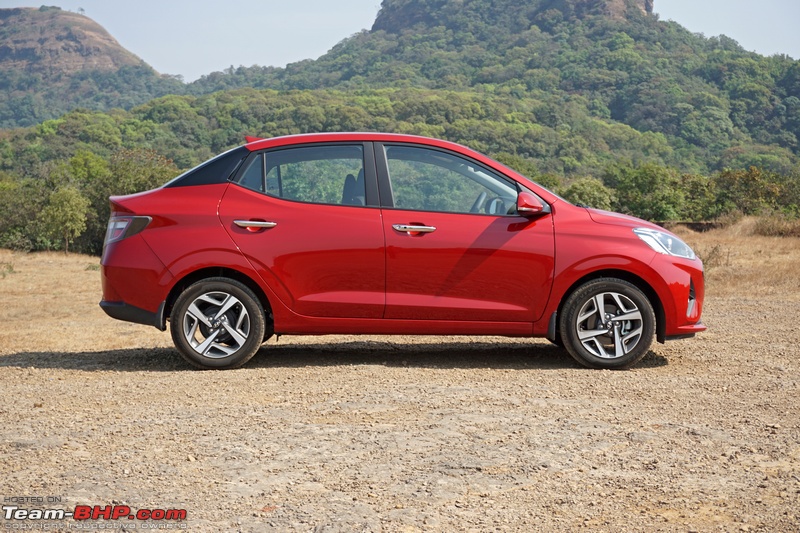 In the sub-4m sedan segment, the Maruti Suzuki Dzire dominates with a 50% market share. The Honda Amaze is a distant second, logging about 5,000 units per month. But, at the moment, there is a good opportunity for other manufacturers to capture market share, thanks to the market leader not offering a diesel engine (post the implementation of BS6 emission rules). While Hyundai has always had cars in the top 10 list of monthly sales charts, the Xcent had never made an impact like the Creta or the Venue. With the introduction of the Aura, the company hopes that it can step in and offer competition to the Maruti Suzuki Dzire and the Honda Amaze. This segment is important as well. It is selling more or less the same volumes as the B1 segment. For manufacturers, this means higher margins on products. While the Aura appears to be a reworked version of the Xcent sedan, it is very nicely kitted. Hyundai has loaded the car with features and even included some segment firsts like the wireless charging, Eco Coating etc. The Aura is based on the Grand i10 NIOS platform, which in turn, is based on the older Grand i10 underpinnings. Hyundai has also priced the Aura competitively in its segment. The AMT comes at a premium of just under Rs. 50,000, while the diesel is priced at a premium of Rs. 1.18 lakhs over the petrol. Note that the diesel also complies with BS6 emission norms. It becomes the third sub-4 meter sedan after the Honda Amaze and Ford Aspire to come with a BS6-compliant diesel engine. Hyundai has priced the car to undercut the Maruti Dzire and the Honda Amaze. It must be noted that while the Dzire is offered with an AMT like the Aura, the Amaze comes with the much superior CVT gearbox. One thing that we don't like is the missing automatic + turbo petrol in the top-spec SX(O) variant. You can get an AMT in the SX+ variant. While feature-wise you don't lose much, the AMT in the SX(O) variant would have been a good option for potential buyers. A factory-fitted CNG option is also offered in the S trim. The Aura is well built with 65% advanced and high strength steel used in its construction; the doors, tailgate and bonnet have a good deal of weight to them. The doors shut with a nice, premium sound. You hardly get to see this with budget sedans. It's very satisfying. There's very little flex if you press the metal with your thumb. The fit and finish are typical Hyundai and quality is top class, inside out. The Aura has a kerb weight of 900 kg for the 1.0L turbo petrol. The paint quality is as good as we’ve seen in the segment and the panel gaps are even. 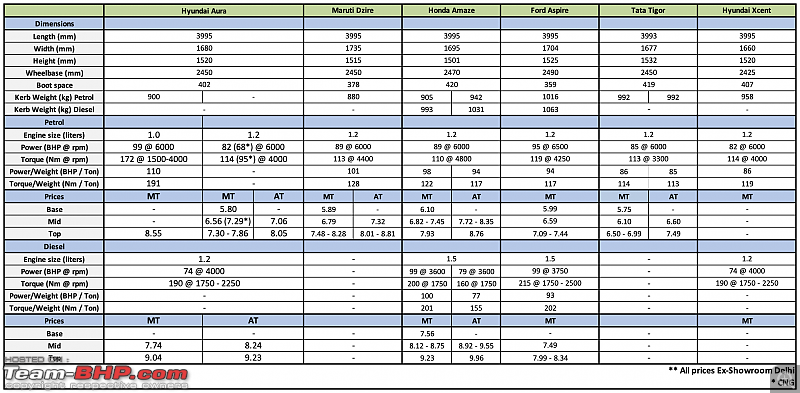 To power the Aura, Hyundai has used a 1.2L, 4-cylinder petrol and a 1.2L turbocharged diesel engine. A 1.0L, 3-cylinder turbocharged petrol is also available. All engines are paired with a 5-speed manual transmission. The 1.2L petrol and diesel engines are offered with an optional 5-speed AMT as well. An automatic option for the turbo petrol would have been a welcome addition, especially since the same engine is offered in the Venue with a 7-speed DCT. Coming to safety, the Aura is equipped with dual front airbags, ABS + EBD, ISOFIX child seat mounts, rear parking sensors, emergency stop signal, seatbelt reminder (for driver + front passenger) and a high speed alert system as standard. Central locking, impact-sensitive door locks, speed sensing auto door locks and rear defogger are not offered on the base trim. The top 3 trims come with a reverse camera. As of date, the Aura has not been crash tested by independent entities like the NCAP. Hyundai is offering a choice of 3 years / 1,00,000 km, 4 years / 50,000 km or 5 years / 40,000 km as the standard warranty. That's quite unique & very welcome! Extended warranty upto 5 years / 1,40,000 km can be purchased additionally. We strongly recommend this extension if your usage is high. Hyundai is further offering 3 Years Road Side Assistance with the Aura. Overall, we'll say that the Aura is an all-rounder of a small sedan, but it's not without its flaws. It's a typical Hyundai; an improved Xcent. The fascia is dominated by a large, black grille with twin boomerang-shaped LED daytime running lights, flanked on both sides by projector fog lamps in triangular housings. Projector headlights sit above the grille. Use of chrome is subtle and overall, the front end is easy on the eyes: 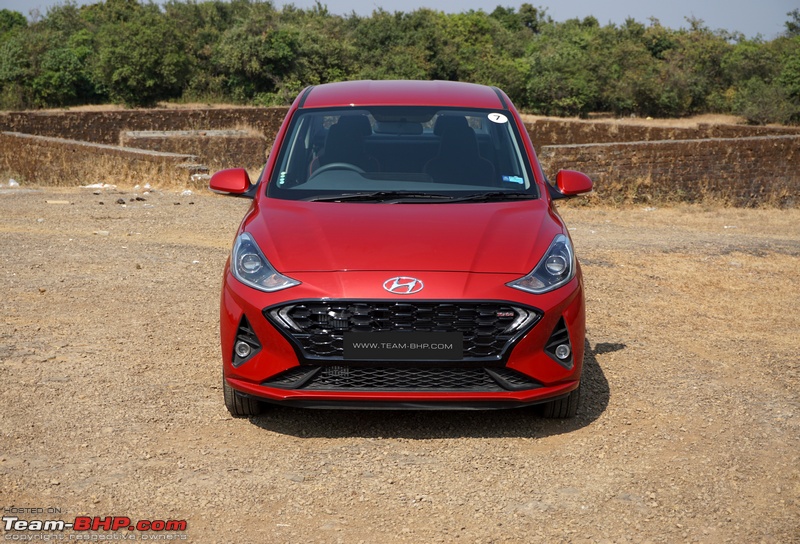 At the rear, things appear busy. The tail-lamps are joined with a chrome strip and a prominent lip on the boot lid. The number plate is housed in the bumper: 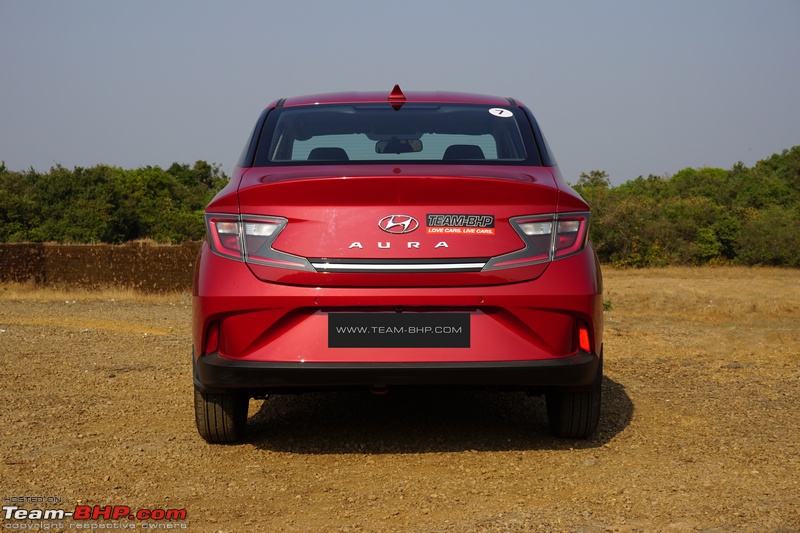 Looks like an improved Xcent rather than an all-new car. Compare their side profiles and you can see that the 3 pillars & silhouette are exactly the same: 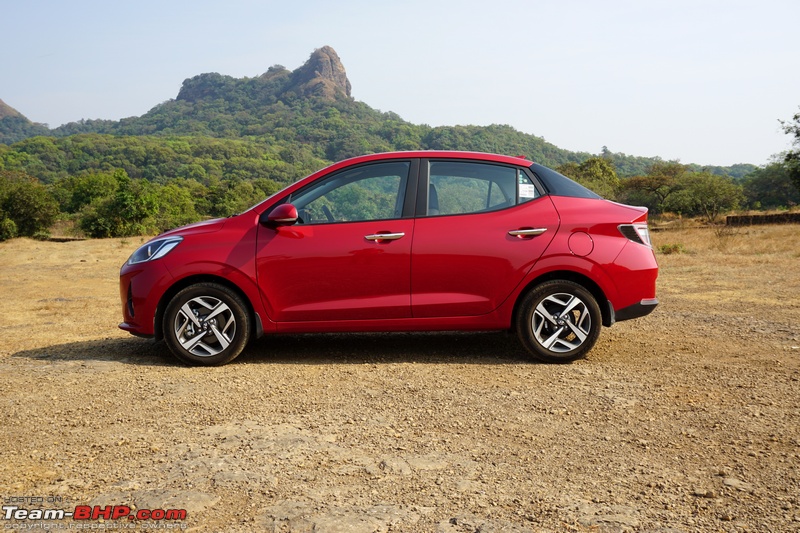 The Aura measures 3,995 mm in length, 1,680 mm in width and 1,520 mm in height, with a wheelbase of 2,450 mm: 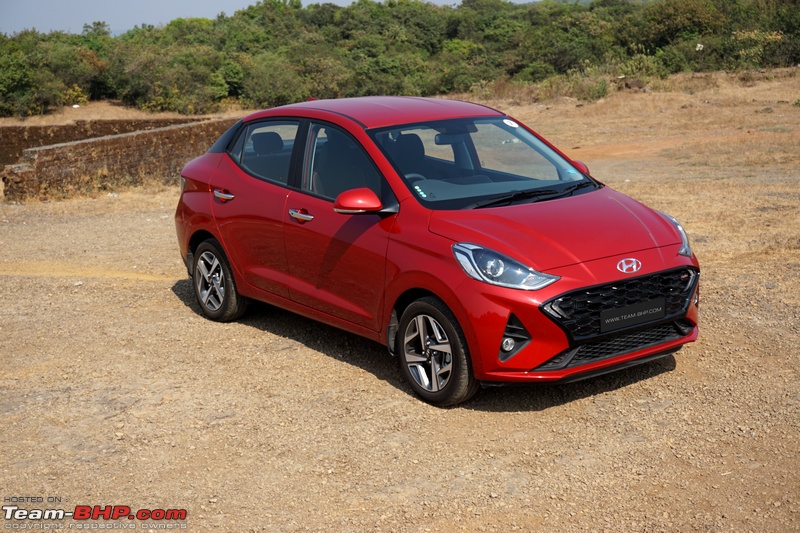 Initial impressions on the rear were a strong dislike, but after 2 days with the car, it grew on us. Guess Hyundai needed a "differentiator" to stand out. Still looks weird though: 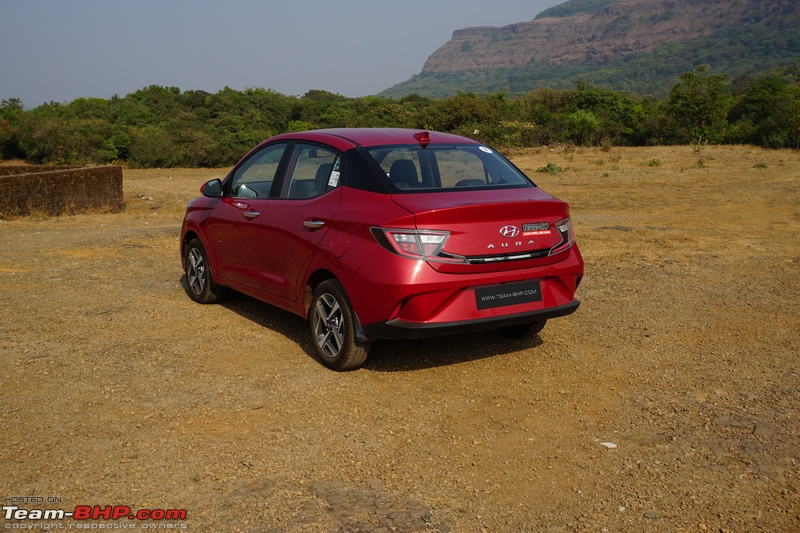 Top-end variant is equipped with projector headlamps. No LEDs here sadly, only regular halogen units. Notice the chrome inserts inside the headlamp cluster: 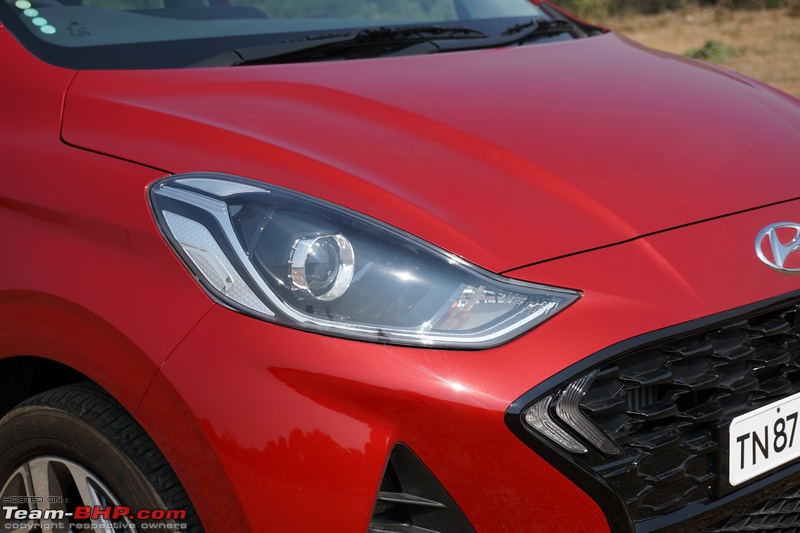 A closer look at the detailing: 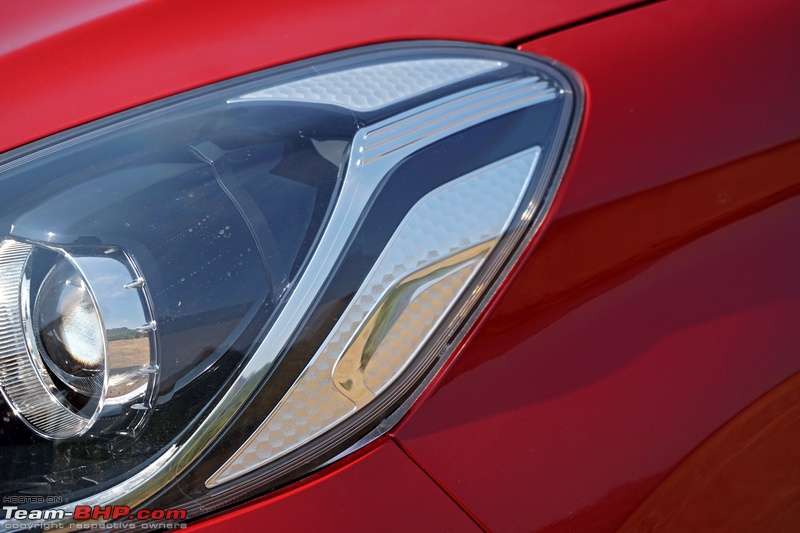 A look at the headlamp cluster with all the lights in action. The headlamps have the 'follow-me-home' feature. Turn-indicators are located in the inner portion: 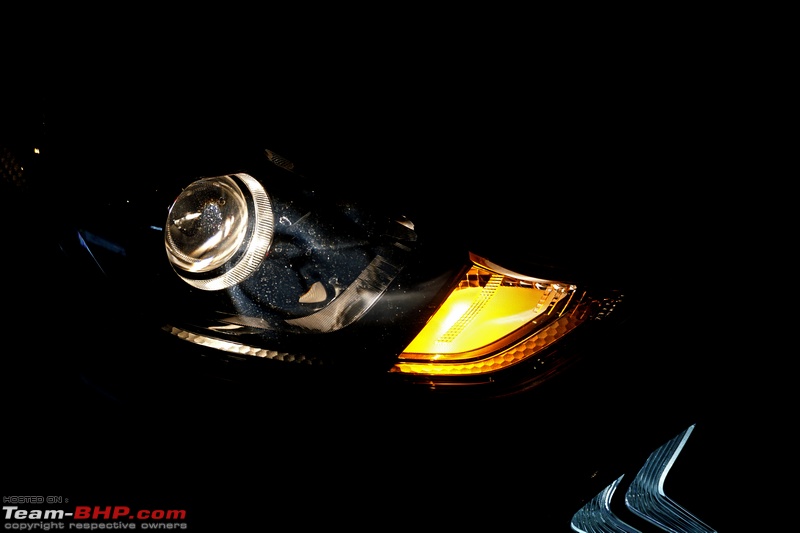 Twin boomerang-shaped LED DRLs are bright and prominent, even under sunlight. They are on all the time; switching on the pilot lamps makes them dim a little: 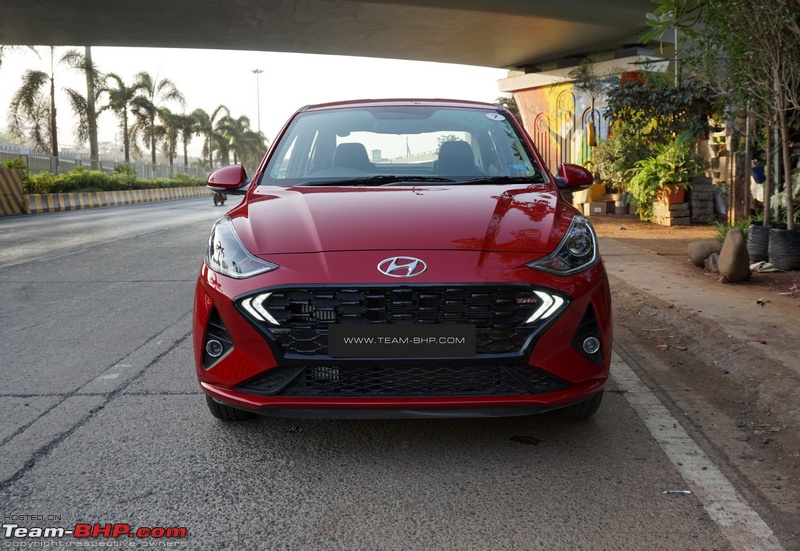 Large cascade grille gets a gloss black border with hexagonal openings. The lower part (along the number plate area) is blanked off: 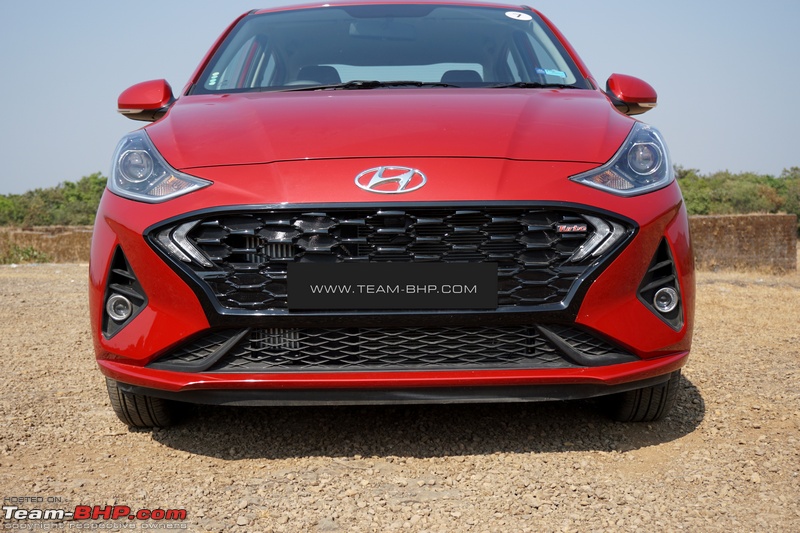 "H" logo sits above the grille: 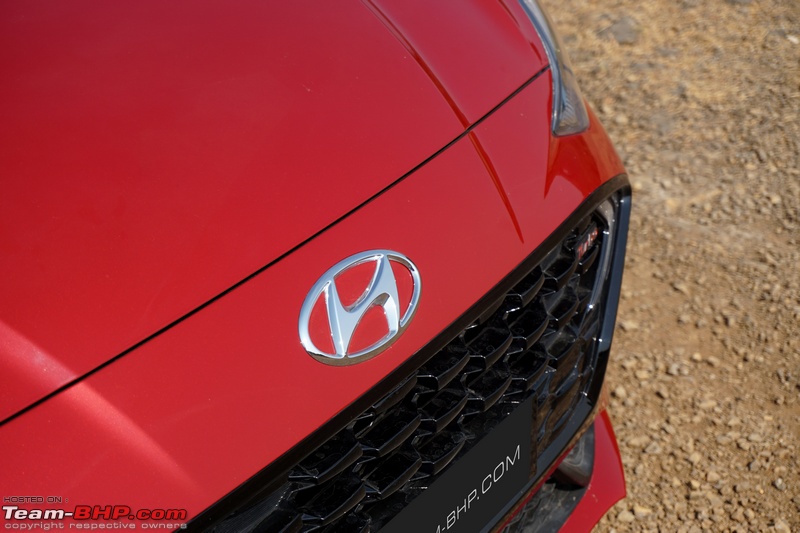 Turbo-petrol gets a lovely red badge: 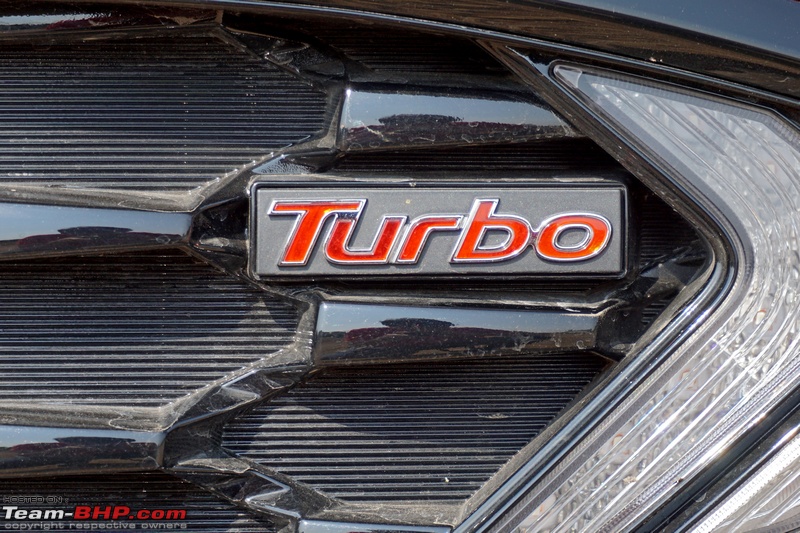 Vertically-stacked intercooler is on the left side of the engine bay. Front towing point is located below the DRL. Its cover is nicely concealed: 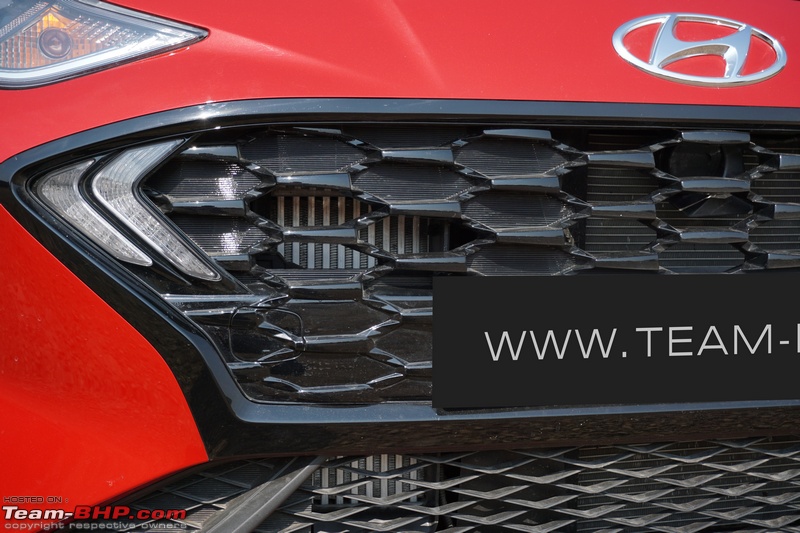 Wide air dam has L-shaped inserts at both ends: 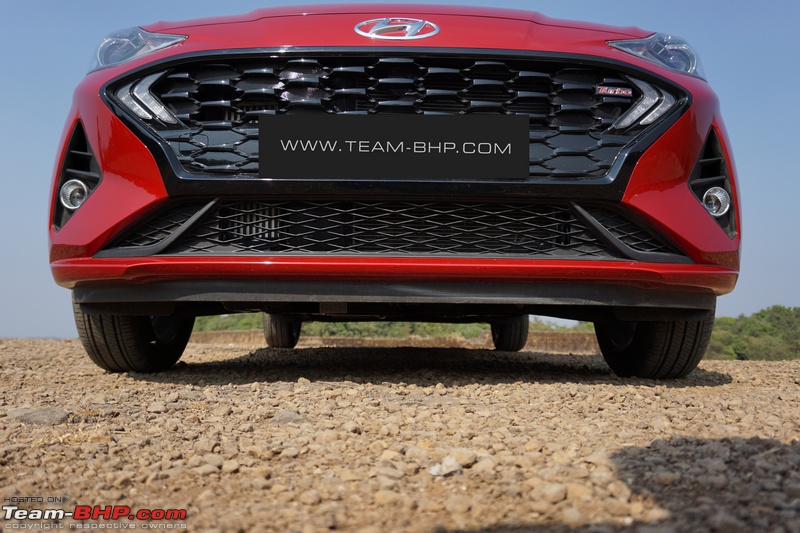 Projector fog lamps get chrome borders. They are adequately bright: 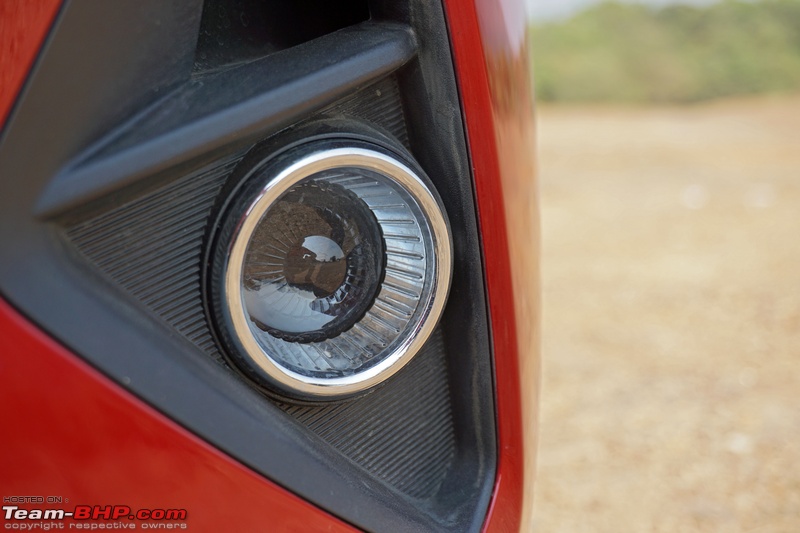 The Aura gets a full-width wind deflector at the front. The bumper also gets a lip that juts out: 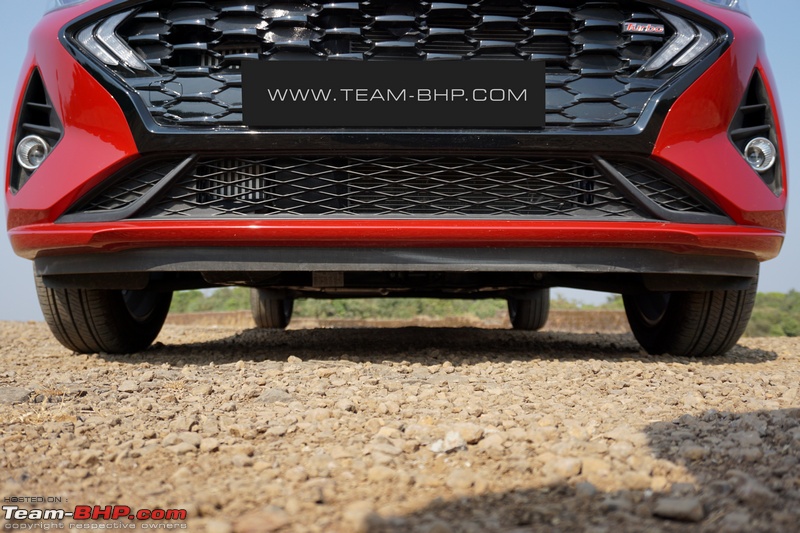 This is how much the lip juts out of the bumper: 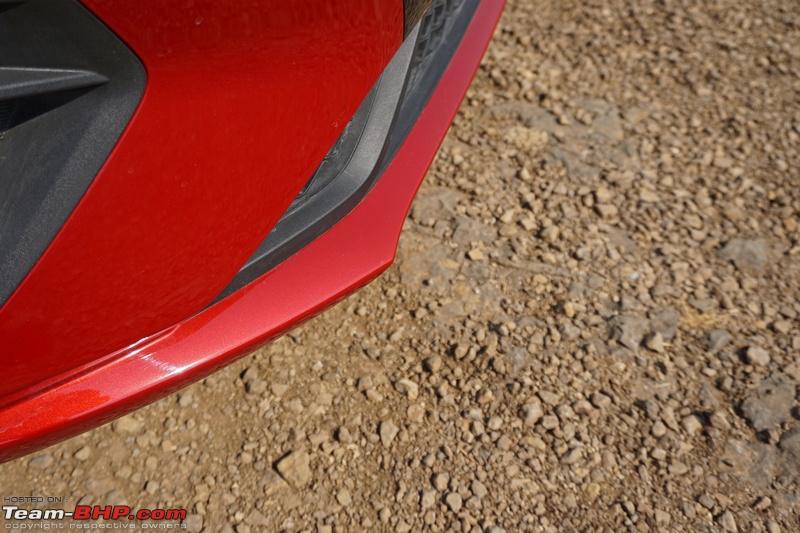 Shockingly, no underbody protection at all! Not even a plastic cover below the engine. Couple that with the unladen ground clearance of just 163 mm, and it does get concerning: 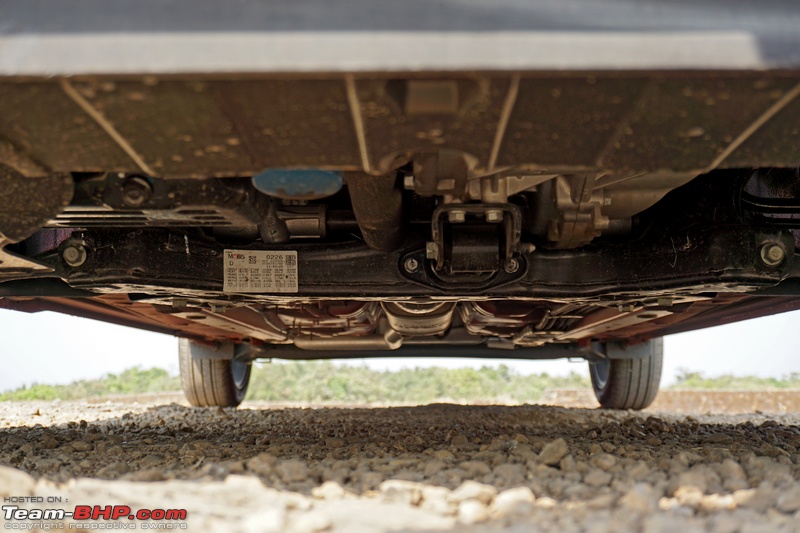 Bonnet has four creases, which extend into the top of the bumper. The central V-shaped bulge leads to the Hyundai logo: 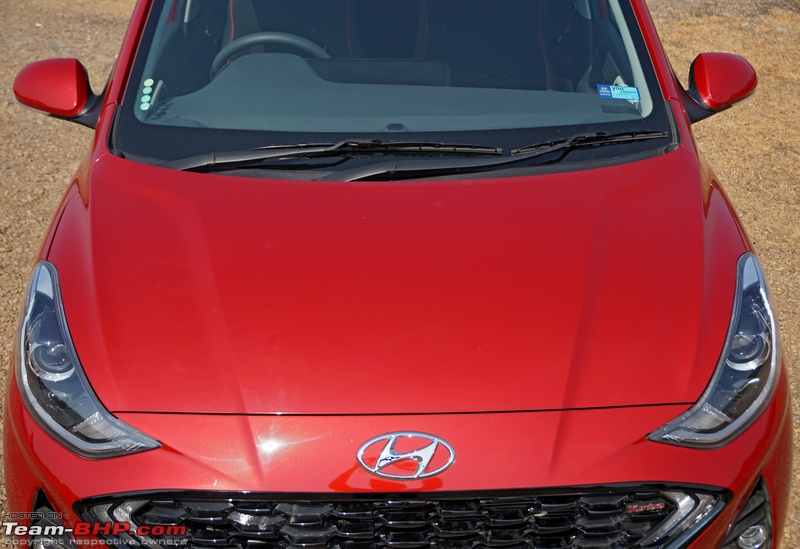 Wiper spindles are concealed under the bonnet... 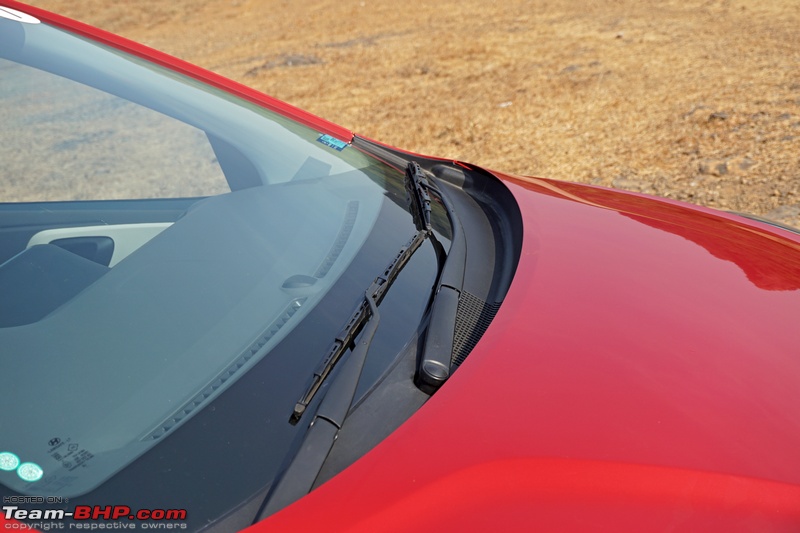 ...as are the windshield washers: 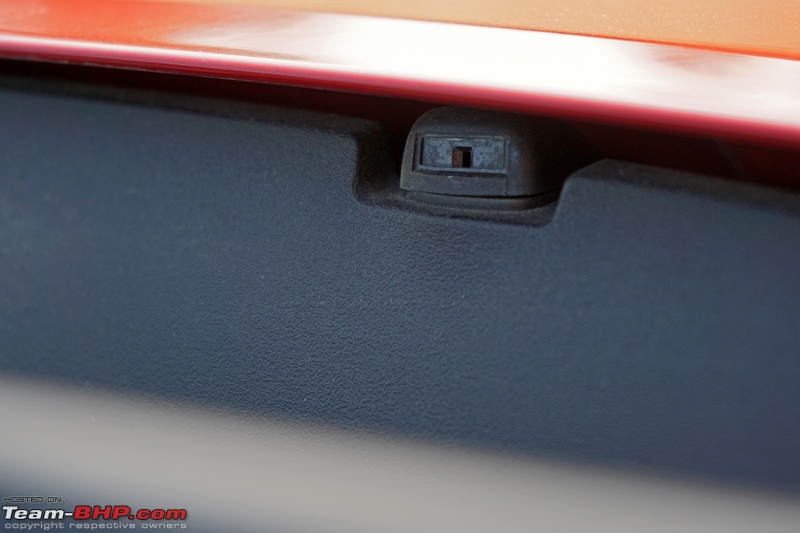 Both windshield washers squirt out effective sprays (rather than jets) of water. The wipers have a good sweep: 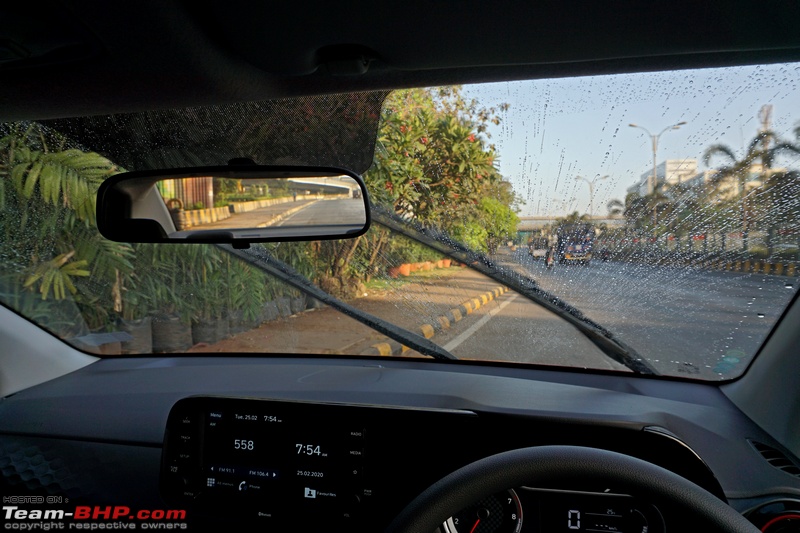 Dual-tone ORVMs are electrically-foldable and have integrated turn-indicators with chrome inserts. They also have an auto-folding function on lock / unlock: 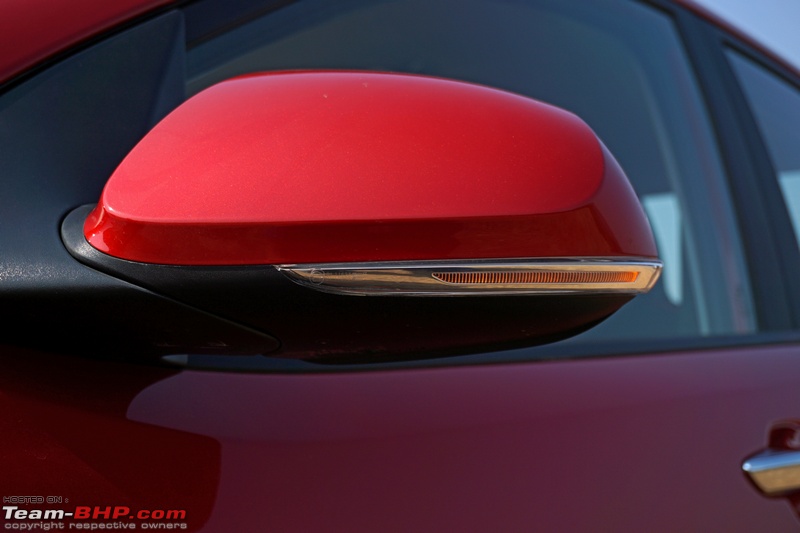 SX, SX+ and SX(O) variants get chrome door handles with a black request sensor on the driver's door. No request sensor or keyhole on the front passenger's door: 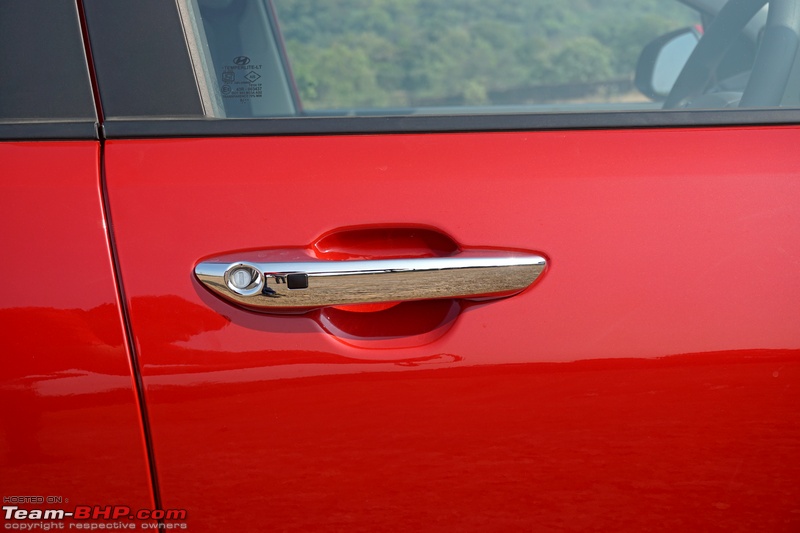 B-pillar gets matt-black, while C-pillar is finished in gloss black. No chrome strips on the window line (we like it this way): 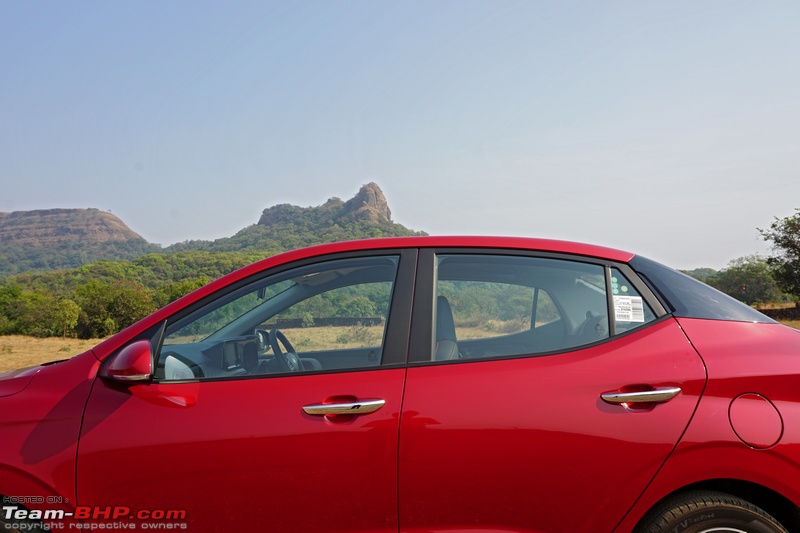 Black portion on C-pillar starts from the rear window and merges into the rear windshield: 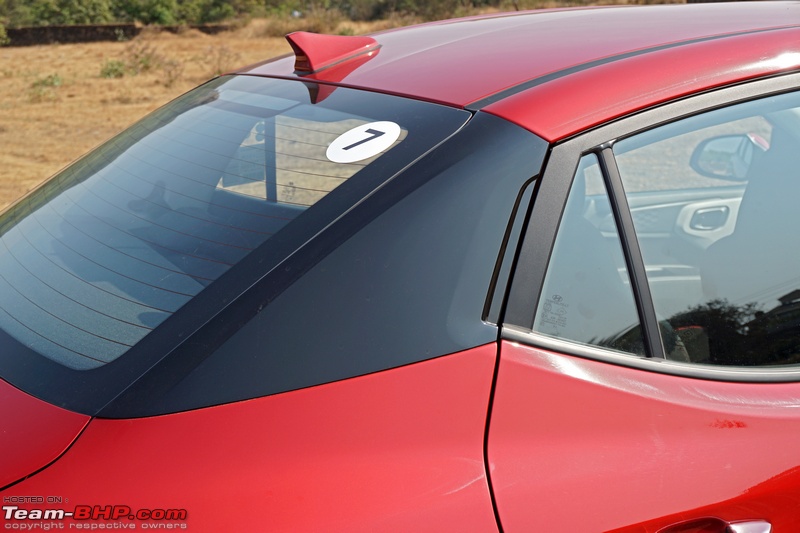 Sides have a couple of mild crease lines running along them: 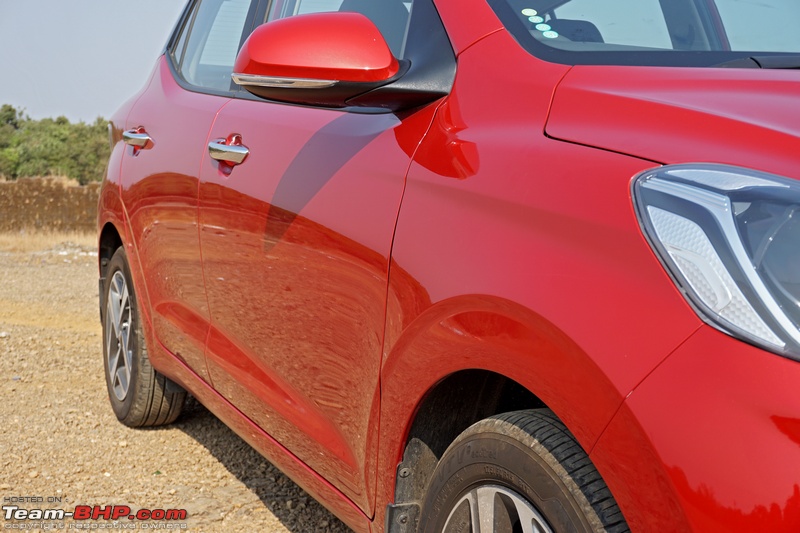 Things get busy at the rear with multiple creases that attempt to merge the sides with the rear: 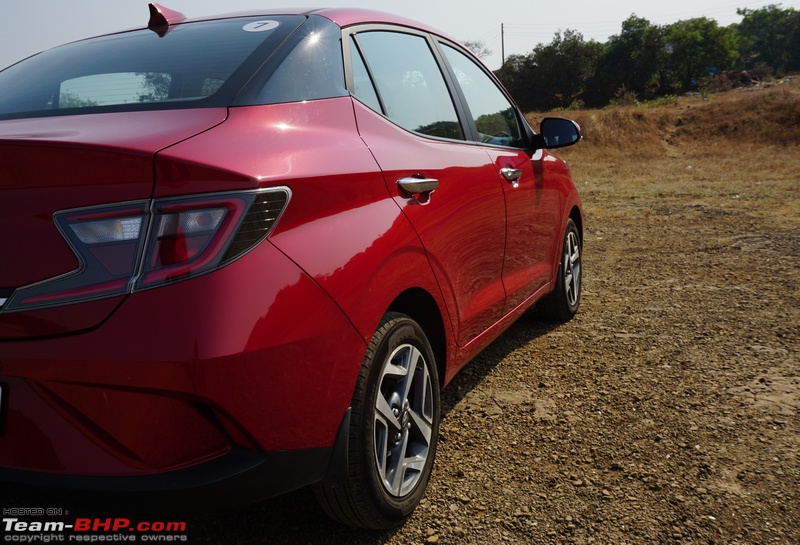 There's a prominent haunch that originates on the rear door and runs across the rear panel. A bit sports car-like: 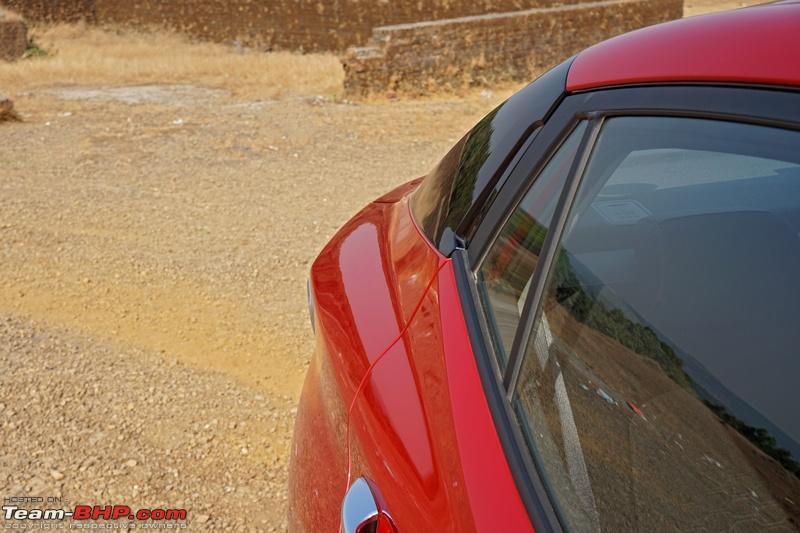 SX, SX+ and SX(O) variants get 15-inch, dual-tone, diamond cut alloy wheels. They look neat and are shod with 175/60 R15 MRF ZVTV tyres. They successfully manage to fill the slightly beefed up wheel arches. However, the tyres are too thin. At least the flagship engine (turbo petrol) should have gotten 185 / 195 mm tyres: 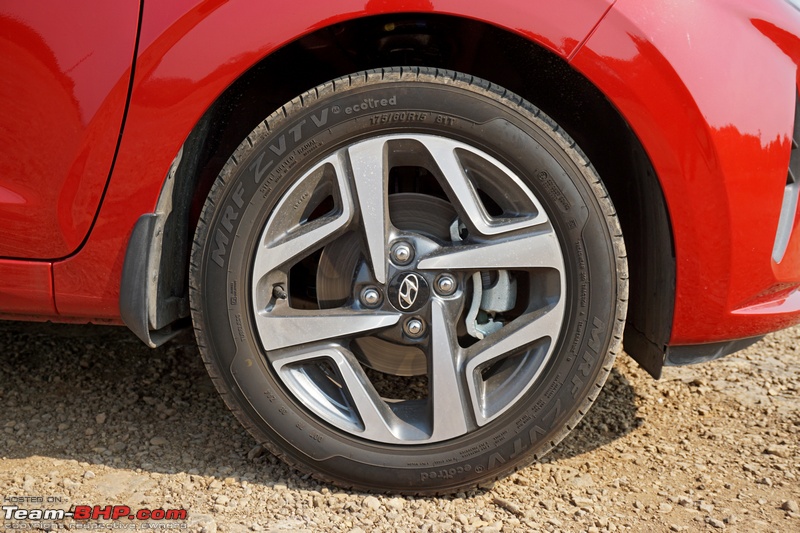 Functional vents ahead of the front wheels are wheel air curtains: 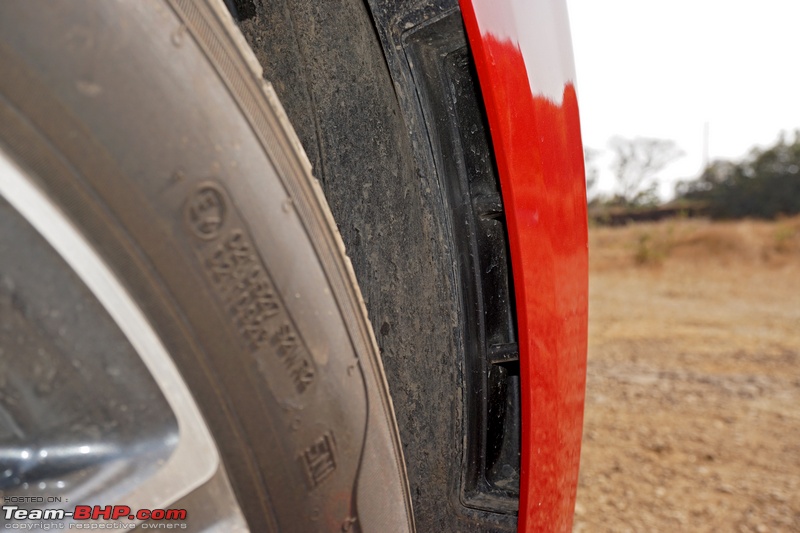 Small flaps ahead of the front tyres... 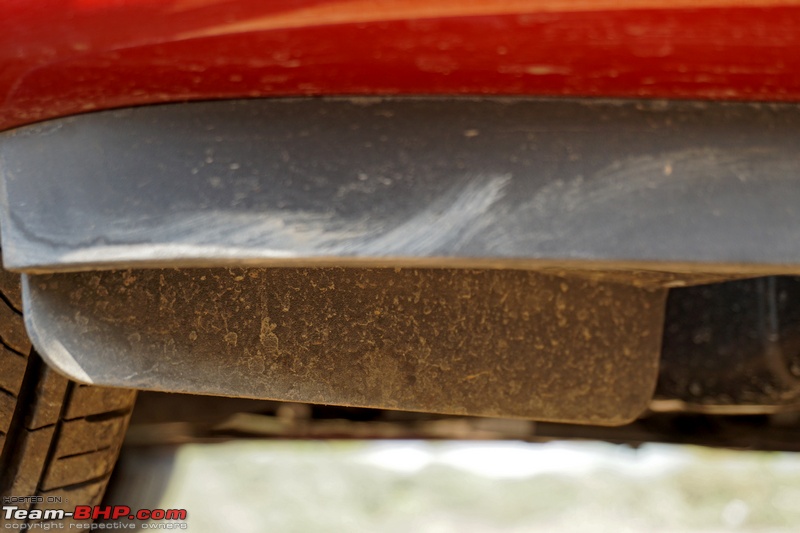 ...as well as the rear ones: 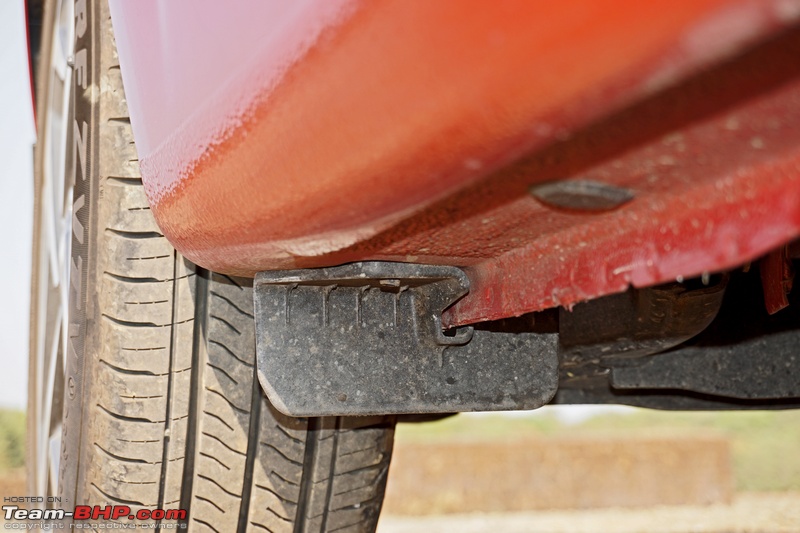 Roof gets two crease lines in the middle: 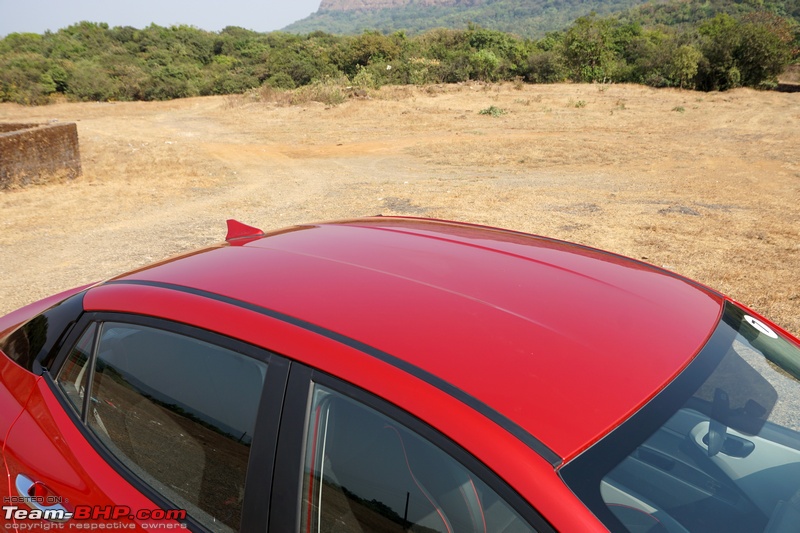 Sharkfin antenna sits at the rear: 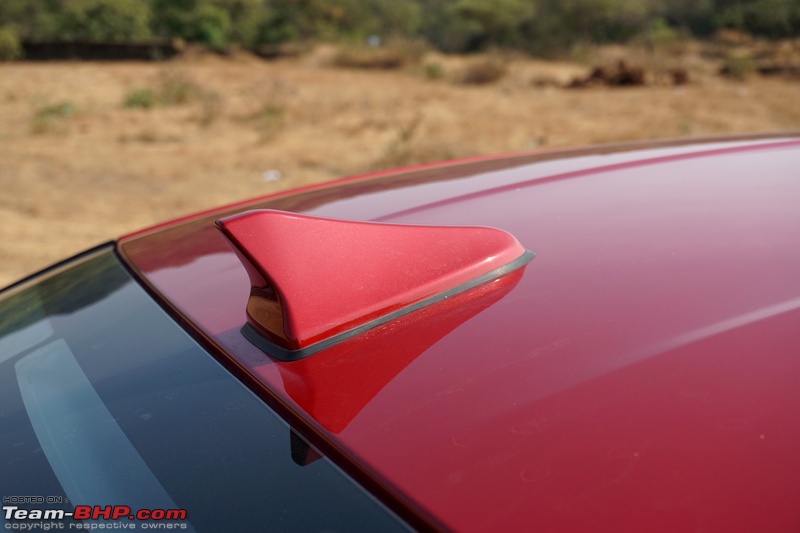 2-piece tail-lamp clusters get C-shaped LEDs as pilot lamps. While the indicator and brake lights are housed in the outer section, the reversing light is on the boot lid: 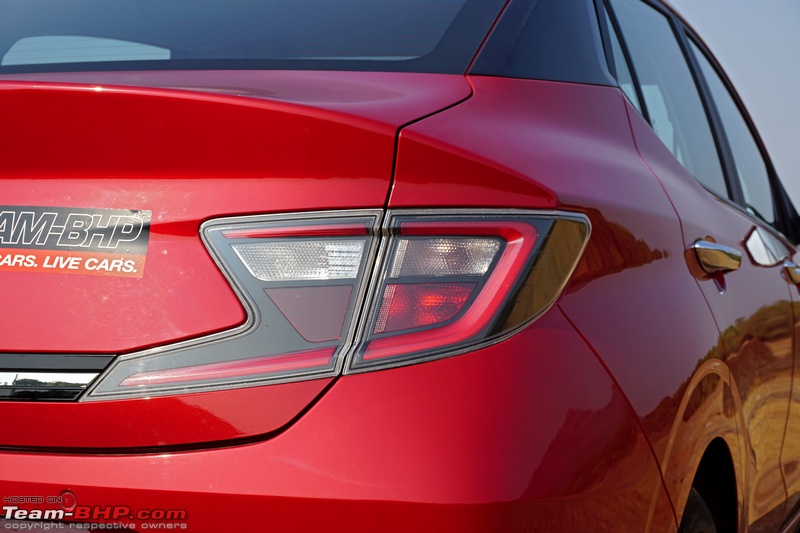 A look at the funky tail-lamp cluster in action. C-shaped LEDs look good at night. Reversing lamps are provided in both tail-lamp clusters. Turn-indicators blink once on locking and twice on unlocking the car. Rear fog lamps have not been provided: 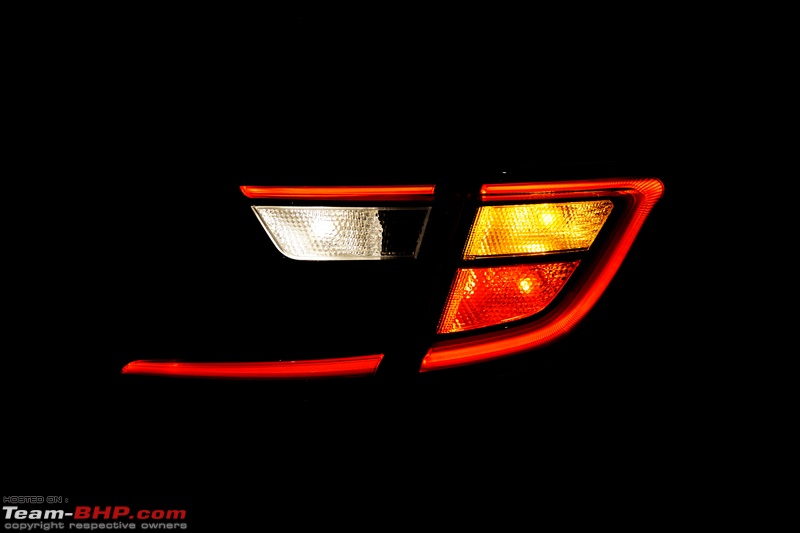 Large "H" badge sits right at the center with "A U R A" lettering below. A chrome strip with gloss black strips around it connects the tail-lamps, just above the bumper. It's a funky rear end for sure; polarising, but Hyundai needed a differentiator in the sea of compact sedans: 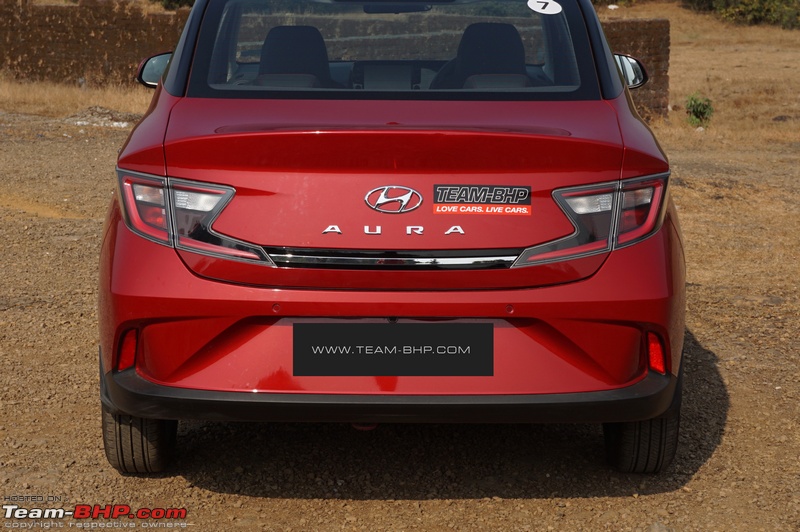 Rear bumper has a recessed area which houses the number plate. The lower edge is finished in black. Only 2 parking sensors provided - feels like unnecessary cost cutting. Vertically oriented reflectors are placed at the edges: 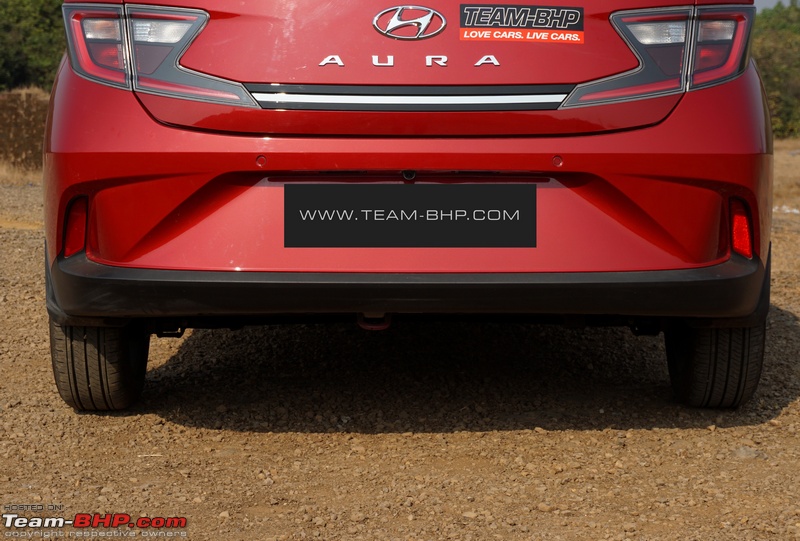 SX, SX+ and SX(O) variants get a reversing camera. It is neatly integrated: 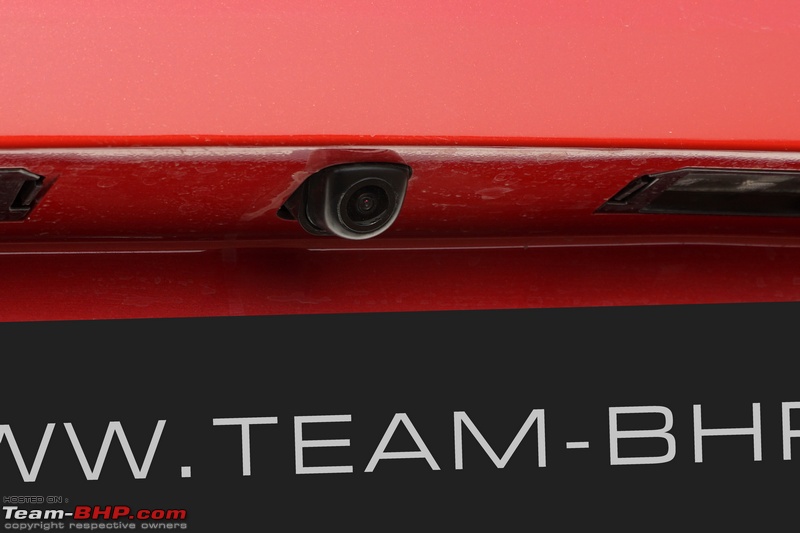 Boot lip is prominent: 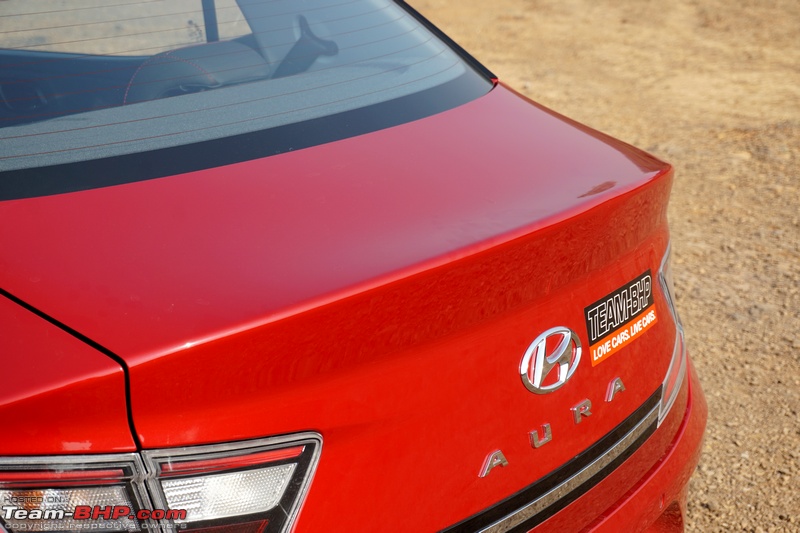 Neat, tidy & organised - As Hyundais usually are. Tow hook is in the center: 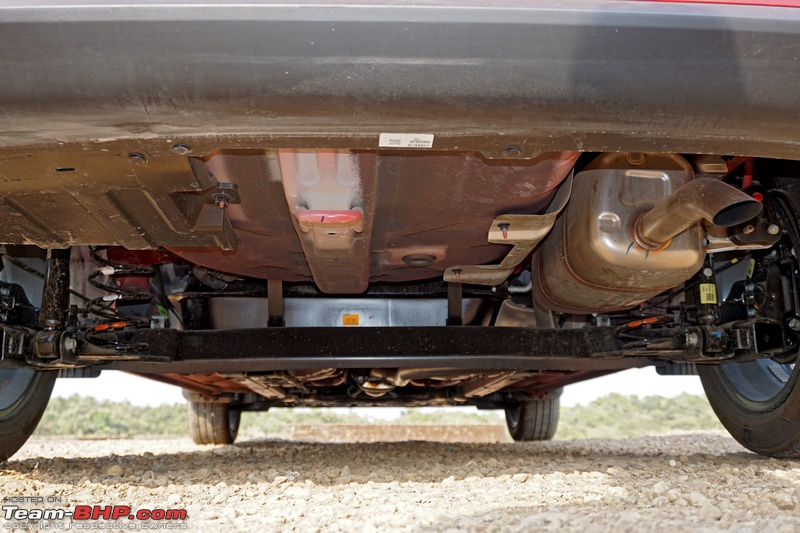 Last edited by GTO : 19th May 2020 at 09:33. |
| |  (28)
Thanks (28)
Thanks
|
| The following 28 BHPians Thank blackwasp for this useful post: | 2himanshu, A.M., akshay81, CarguyNish, CrAzY dRiVeR, fiat_tarun, Gannu_1, GTO, InControl, keroo1099, libranof1987, MSAneesh, noopster, NTO, Obi-Wan, Omkar, Ponbaarathi, RavenAvi, Reinhard, Sachin V.W., Simat, smuniswami, theexperthand, TROOPER, vaish9925, Varun_HexaGuy, vb-saan, Venkatesh |
| | #4 |
| Senior - BHPian | Interior - Front 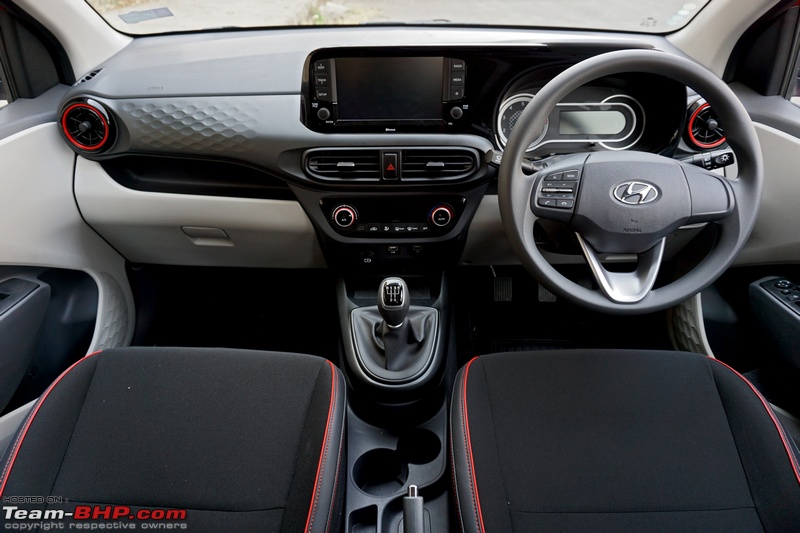 The front doors open and shut in a triple-stage action. They feel good and are not light like those seen in some other Asian cars. The doors open wide enough and the running board is not wide either. However, while the floor of the car is not high, the roof is on the lower side, so you have to bend a bit to get in. This is very noticeable as the driver's seat is at a lower position than you expect and you have to sit down in it. In terms of the ergonomics, the cabin is well laid out and all controls are easy to find and reach. The Aura is well-packaged in terms of cabin space. There’s good legroom & headroom at the front. The front & rear windshields are well sized, the roofline rises slightly towards the middle before tapering down. There is enough light entering the cabin. The interiors have a dual-tone theme, which makes it pleasant as well as practical (the contact areas are black). The styling of the dashboard is functional & contemporary. The dashboard of the turbo-petrol is black & whitish grey with red highlights. Funnily, Hyundai calls this an all-black theme. While doorpads are black and whitish-grey as well, the seats, carpets and floor mats are black. This will conceal any signs of soiling. Additionally, the roofliner is whitish-grey. Other engine options get dual-tone grey interiors. As expected for this segment, the plastics on the dashboard are all hard, but the quality of the plastics is certainly better than the Aura’s main rivals in the segment. Each and every part is well-finished and there are no rough edges anywhere. Typically Hyundai! The seats get a combination of fabric and leatherette (artificial leather) upholstery. It is very easy to find your perfect driving position. The feel, quality and finish of the buttons and switches are satisfactory. Many of these are shared with other Hyundai cars and feel like they are built to last. Hyundai has loaded the Aura with features such as an 8-inch audio video navigation (AVNT) touchscreen head-unit that supports Android Auto and Apple CarPlay, Arkamys premium sound, Eco Coating technology and wireless mobile charging. Disappointingly, some essential features such as auto headlamps, auto wipers and auto dimming IRVM have been skipped. Dual-tone dashboard with the upper section finished in black, while the lower area is whitish-grey. The honeycomb patterned crashpad on the dash is finished in black in the turbo-petrol variant. It is bronze in the other variants. Interiors are well-designed, nice looking and user-friendly. Ergonomics are absolutely perfect with all controls falling easily to hand:  Windscreen is large and offers a good view of the road ahead:  The steering wheel has a silver insert and thumb contours. It is shared with other Hyundai cars and has just the right combination of size and thickness. Steering feels great to hold and offers satisfactory grip. Looks and feels very premium. The hornpad isn't easy to reach for those with shorter thumbs. It is easy to press though. A leather-wrapped steering is offered only on the top-spec SX(O) variant:  Buttons for the infotainment system, telephony and voice commands are placed on the left spoke. Mute function (very useful) can be operated by pressing the volume button inward. Pressing the mute button also pauses the song that's playing, so you don't miss any part of it. What we found weird was that to go to the next track, you have to push the track button down - opposite of what is usually the case. We saw this in the Hector and the Aura's sibling (the Venue) as well. Looks like manufacturers are changing the trend:  Steering can be adjusted for height only, not for reach:  Engine start/stop button has a brushed silver ring around it. Classy! The button glows in white every time the door is opened:  Simple instrument cluster consists of an analogue tachometer on the left and an integrated digital speedometer and MID on the right. It is high quality, crystal clear, uncluttered and easy to read. I like the fact that the speed is displayed in a large font right in the centre. The redline is marked at 6,500 rpm and the needle rests at a sporty 6 o'clock position. Meters are backlit in a classy white. While the Aura gets a digital fuel gauge, a temperature gauge is missing!! Also, note the door ajar warning that displays the top view of the car:  Ugly stalk to toggle between the functions of the MID and reset the trip meters sticks out of the instrument cluster:  MID is black & white and relatively simple. It provides adequate information, including the fuel level in bars, digital read-outs for the odometer, outside temperature, two trip meters, a range / DTE counter and an "R" is displayed if the reverse gear is engaged:  Average fuel economy, instantaneous fuel economy, average speed and time spent are also displayed. These can be reset independently (not linked to any trip meter): 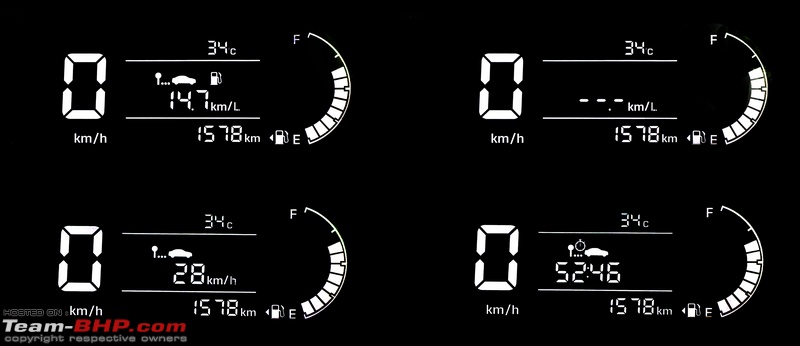 Light and wiper stalks feel nice to use and will last a long time. Left stalk controls the functions for the wipers, whereas the right stalk controls the headlamps and the front fog lamps. Both, automatic headlamps and automatic rain-sensing wipers have been left out, even on the top variant. Lane change indicator is standard on all variants:  Side air-con vents are circular and get gloss black rings with nice red highlights around them. They throw out a serious amount of air:  Rotate the central knob anticlockwise to adjust the air volume. However, even with the vents in the full shut position, some air keeps flowing out:  Switch for the headlamp level adjustment is located below:  OBD port is located at the base of the fusebox. Like some other Hyundai cars, fusebox gets a Master 'On / Off' switch which could help prevent battery drain when the car is parked for a long duration (e.g. this Covid-19 scenario): 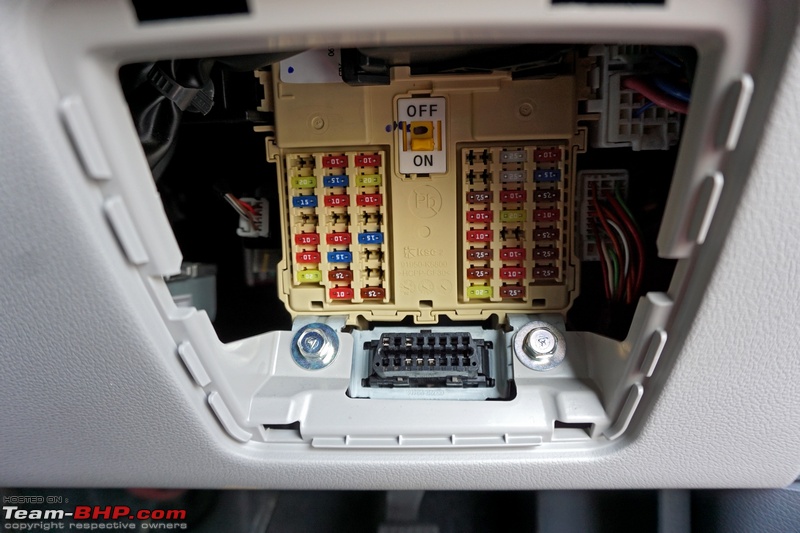 Sturdy bonnet release lever is located below:  Fuel flap and boot release levers are placed conventionally on the floor:  Like the dashboard, the doorpads get a dual-tone theme. The upper portion gets an insert with honeycomb detailing just like the crashpad on the dashboard. While all the plastics are hard, the doorpads are well finished with no sharp edges anywhere. They are scooped out where you would rest your arm:  Door handles get a dark grey metal finish. They feel sturdy:  A closer look at the detailing on the door pad. The contours, colours and the texture make the doorpad appear nicer:  Console houses the usual set of buttons. Only the driver's window gets one-touch up/down and anti-pinch functionality and only the driver’s window button is backlit. In fact, the other window switches are not even marked. Sad. Door mirrors are electrically foldable. ORVM adjuster selector switch is weird. One of the two mirrors is always selected - there is no middle / dead position. So, if by chance, you press the adjuster, one of the mirrors will change its angles. ORVMs can be closed electrically even after the engine is switched off. The opening and closing actions are super silent:  Doorpad can hold a 1-litre bottle, and other small items:  Front seats of the SX+, turbo petrol variant are draped in a combination of fabric and leatherette upholstery. They are good looking, wide and offer a fair deal of support. They have side bolsters, which give good lateral support. However, heavier folk will find these side bolsters digging into their backs. While under-thigh support is good, after ~2 hours of driving, we were wishing for superior back support too. The actual backrest area is too t-h-i-n:  Despite the headrests being integrated and non-adjustable, we found them comfortable:  All variants except the base E get height adjustment for the driver's seat:  Seat upholstery is a combination of fabric and leatherette (artificial leather). Contrast stitching on the sides looks cool. Like most Hyundai cars, the quality of materials used is good:  A closer look at the red piping and the contrast stitching:  Honeycomb detailing continues on the backrest as well:  Seatbelts are not height-adjustable, but are placed at a comfortable height. Both front seatbelts get pre-tensioners:  Pedals are properly spaced out. A usable dead pedal has been provided as well:  While resting your feet on the dead pedal, your shoe touches the clutch pedal (if your shoe size is big). I preferred to rest my feet on the floor due to this:  ORVMs are sufficiently tall and wide. They offer adequate coverage: 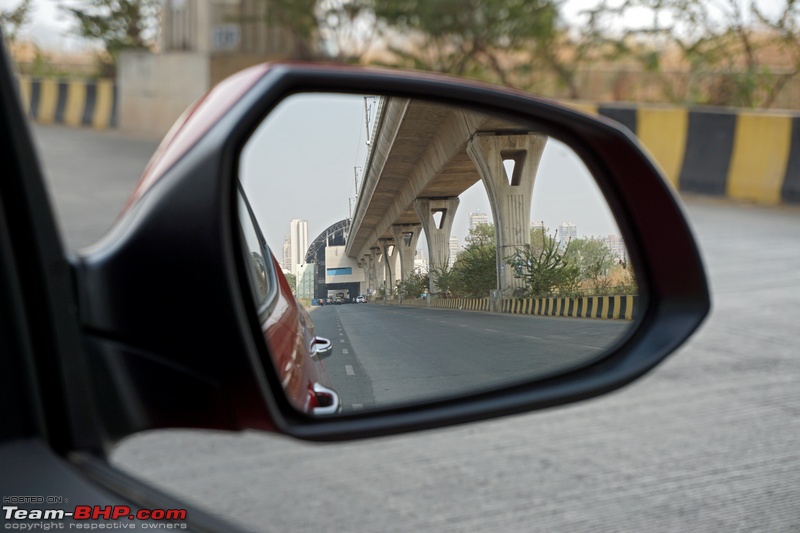 IRVM is wide enough to cover the entire rear windshield:  No automatic dimming for the IRVM. This is a glaring omission. Manual day / night flick switch is provided: 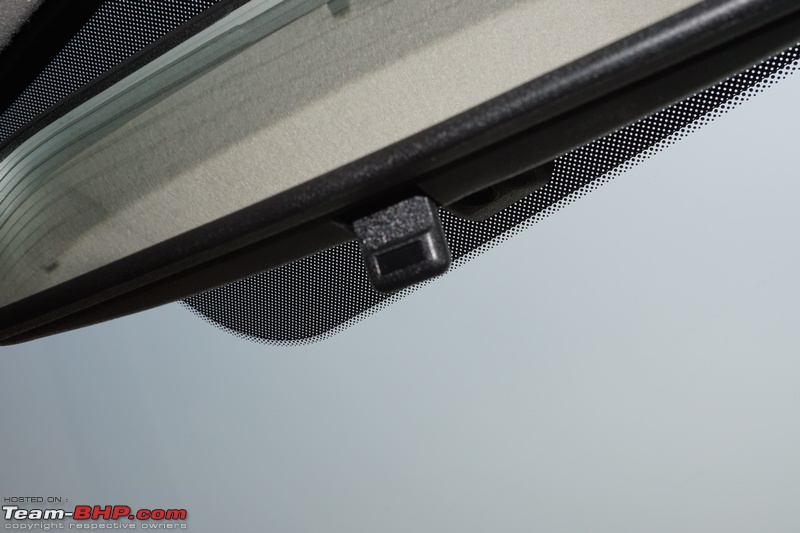 Visibility while reversing is strictly average. The rear headrests don't pose a problem, but the thick C-pillars along with the tall boot, high parcel tray and tapering roofline limit the view. While parking, it is better to take help of the reversing camera and sensors:  Center fascia tilts slightly towards the driver. It features an 8-inch touchscreen head-unit. A thick dark grey border with a metal finish runs around the air-con vents. The air flow direction controllers get silver inserts. Piano black is used around the climate control display and the infotainment screen. Switches and knobs are located on either side of the head-unit:  8-inch touchscreen infotainment AVNT head-unit with HD display is standard on the SX, SX+ and SX(O) variants. Hyundai hasn’t kept up with the advancement in ICE that we’re seeing in the market, overall. We found the audio sound quality to be mediocre. Will give it a 6 / 10 at best, even after setting up the equalizer and all that. The ICE cannot handle bass-heavy songs & the max volume level is quite restricted. Hyundai needs to catch up with some others on this front. One expects a better system when parting with over nine lakh rupees. Audio-inclined owners will have to upgrade the speakers, but that comes with its own challenges (e.g. fit & finish in the after-market):  Just see how neatly the head-unit has been integrated into the dashboard: 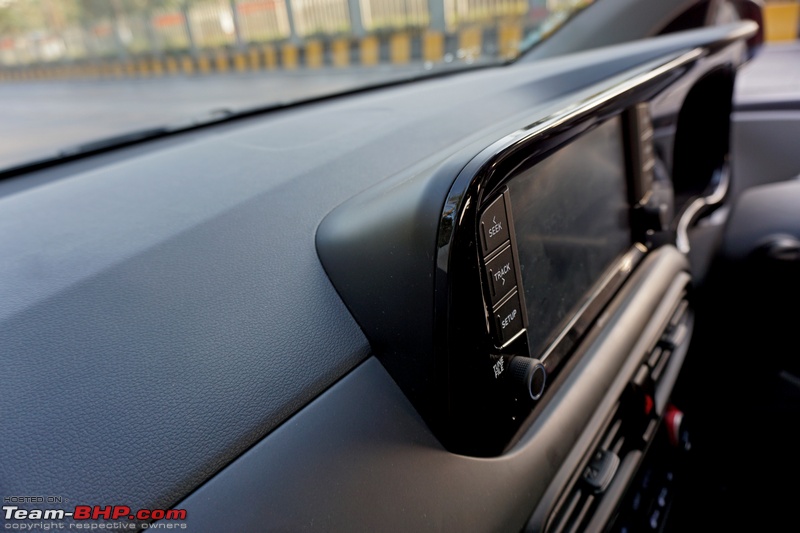 Climate control system gets easy-to-read black buttons and red inserts on the knobs. The blower has 7 levels of adjustment. At levels 1 and 2, it is silent. At levels 3 and 4, it gets audible. At level 5, it is loud, while on levels 6 and 7 - the noise is excessive. The lowest temperature that the system goes to is 17 degrees centigrade before hitting 'LO', while the highest temperature level is 27 before hitting 'HI'. The cooling performance is very impressive. Hyundai has equipped the Aura with Eco Coating - a technology that is claimed to eliminate air-conditioner odour:  2 USB ports and a 12V power outlet are located below the climate control system on the center fascia. The USB port on the right can only be used for charging, while the one in the middle can be used to connect your smartphone to the infotainment system as well as for charging purposes. 12V power outlet gets a flip-up plastic cover. Hyundai has provided a plug-in USB port that can be slotted into the 12V charging socket as well. It comes with a plastic cover. Pretty sweet!  The base of the center fascia features a wireless smartphone charger - a first-in-segment feature. You need a compatible smartphone for this to work. Warnings at the top ask you to not place any coins or the smartkey here. Function lights are located on the right: 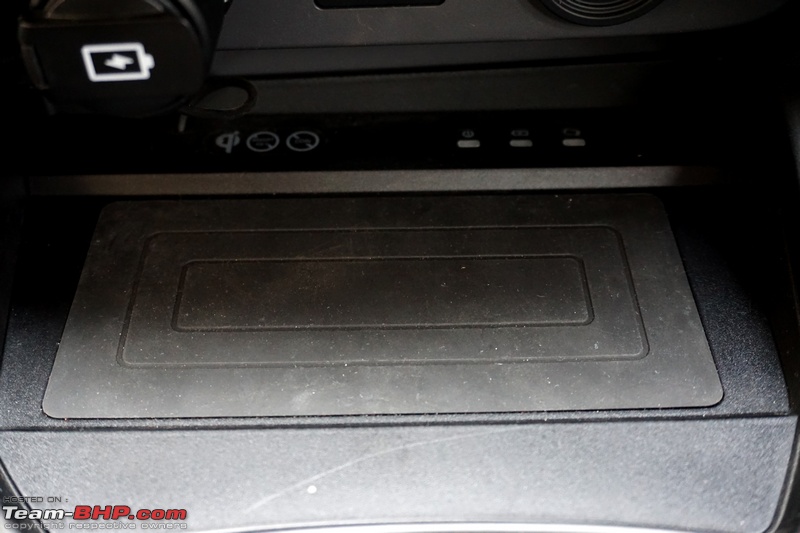 Bird's eye view of the handbrake console. Hyundai should have given a center armrest with a storage box in this car:  Two cupholders of different sizes have been provided: 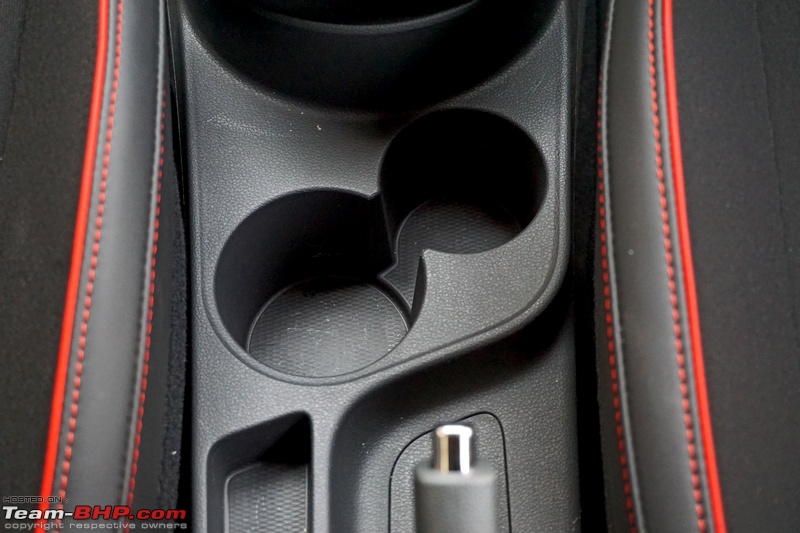 Narrow storage space next to the handbrake: 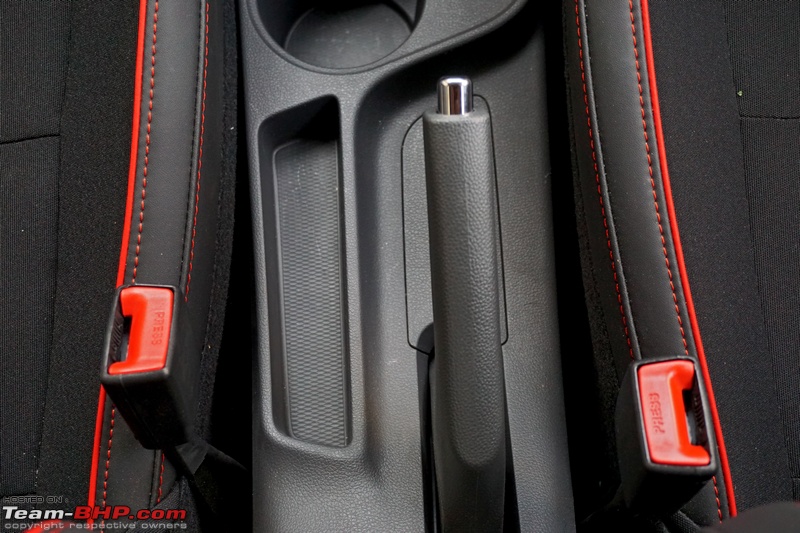 Long and fairly deep storage spot above the glovebox gets a lip to keep parked items from falling. This is a good place for the front passenger to keep his smartphone and other small items. Just be sure the doors are locked & the window rolled up to reduce the odds of theft: 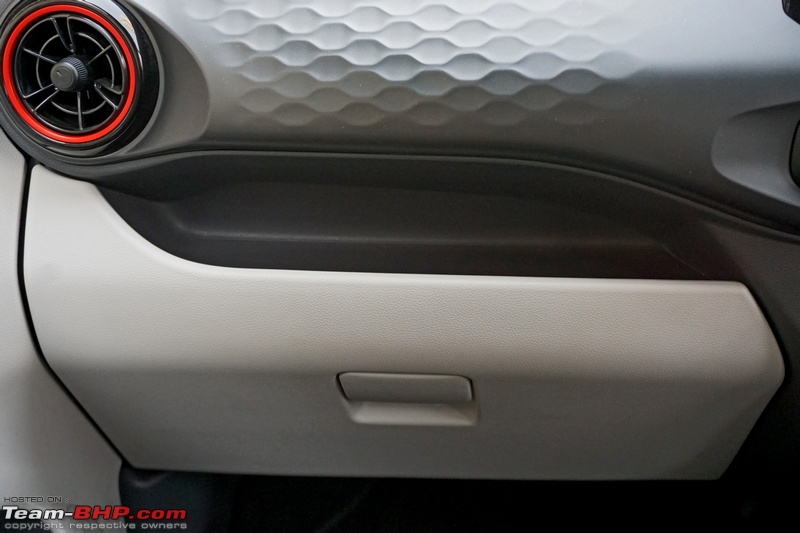 Glovebox is medium-sized. It does not get any partitions or compartments: 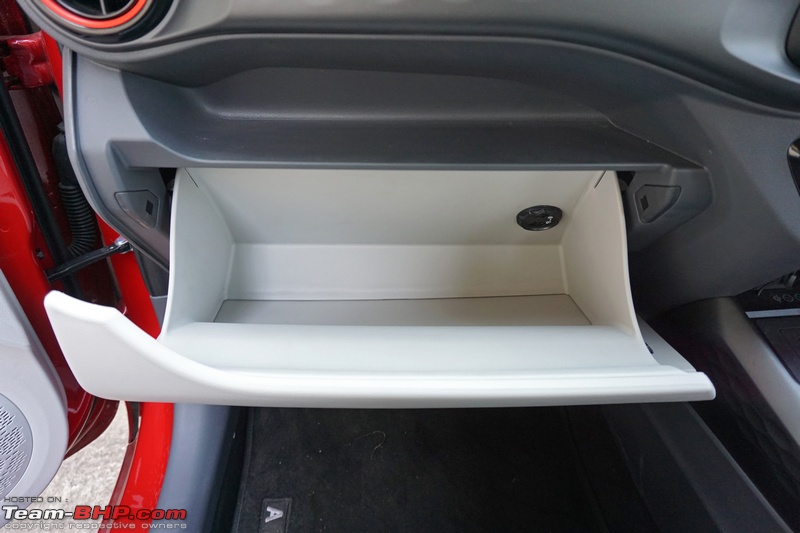 While a cooling vent has been provided, there is no illumination: 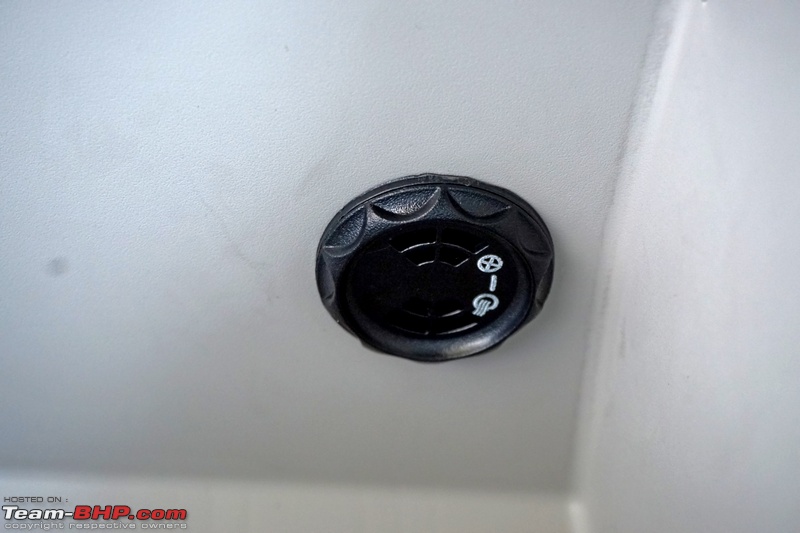 Roof bezel consists of the cabin light. After locking the car, all cabin lights go out with a theatre-dimming effect. Even if the cabin lights are left in the ON position, they will go off when you lock the car from outside (to prevent battery drain). No sunglass holder provided: 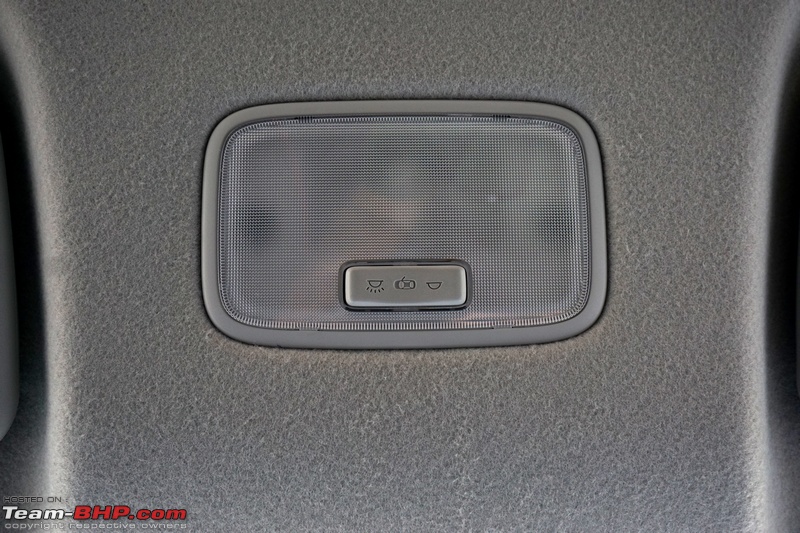 Bluetooth mic is positioned above the driver on the roofliner. It looks like an afterthought: 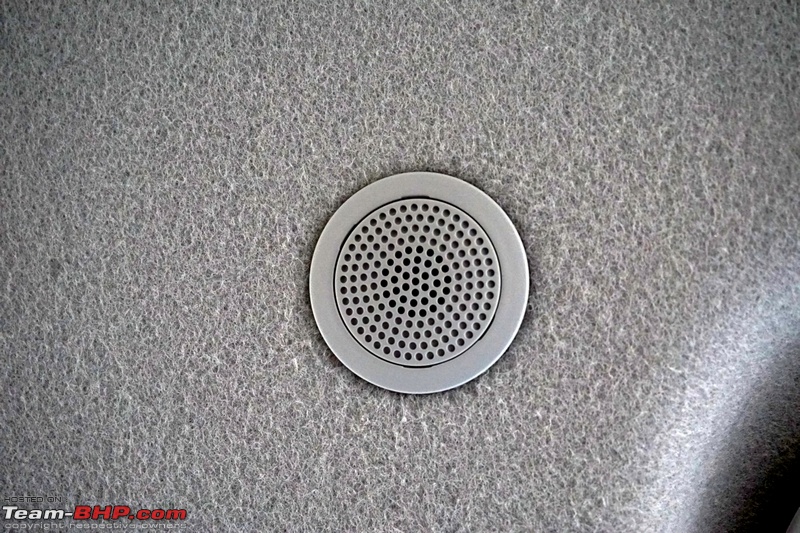 Sunvisors are economy-grade in design, yet they don’t feel flimsy. Driver-side unit gets just a flap to hold tickets, while the passenger-side sunvisor gets a vanity mirror. But there's no cover or light provided: 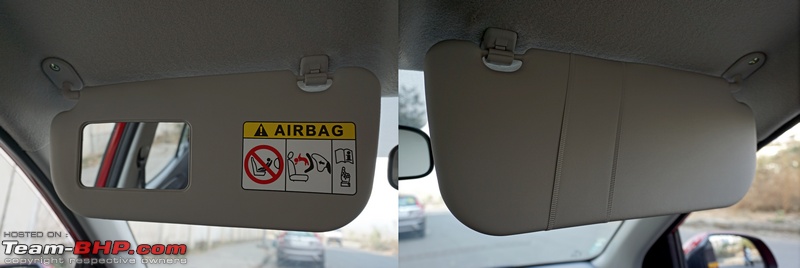 Dual airbags are standard on all variants of the Aura: 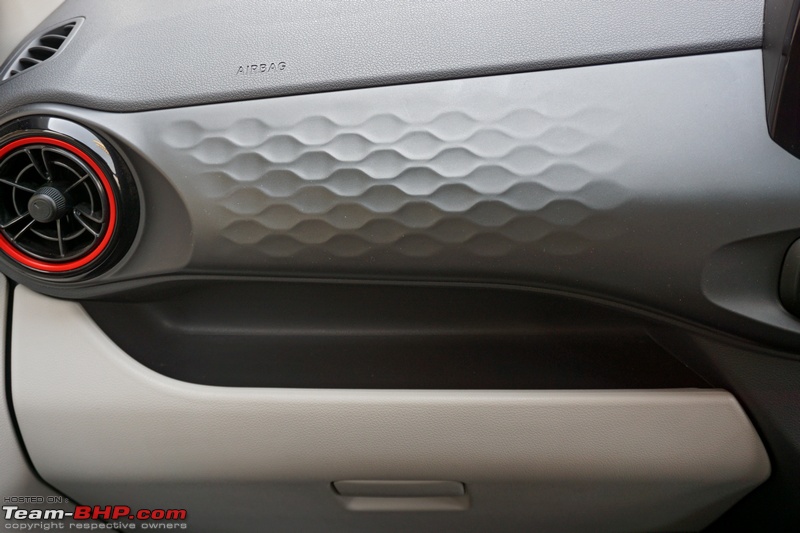 Things are neat and tidy even in places where most owners won’t look. There are no loose wires or cables dangling anywhere. Here's a sneak peek below the dashboard in the driver's footwell... 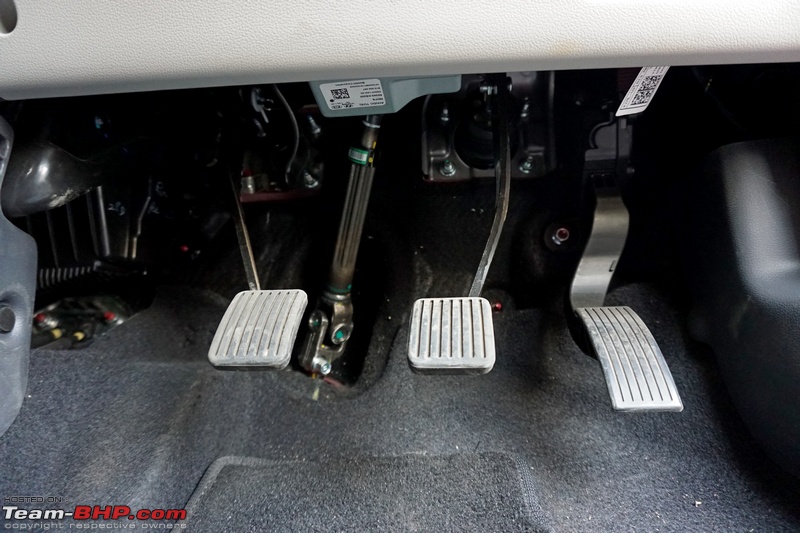 ...and the passenger's footwell: 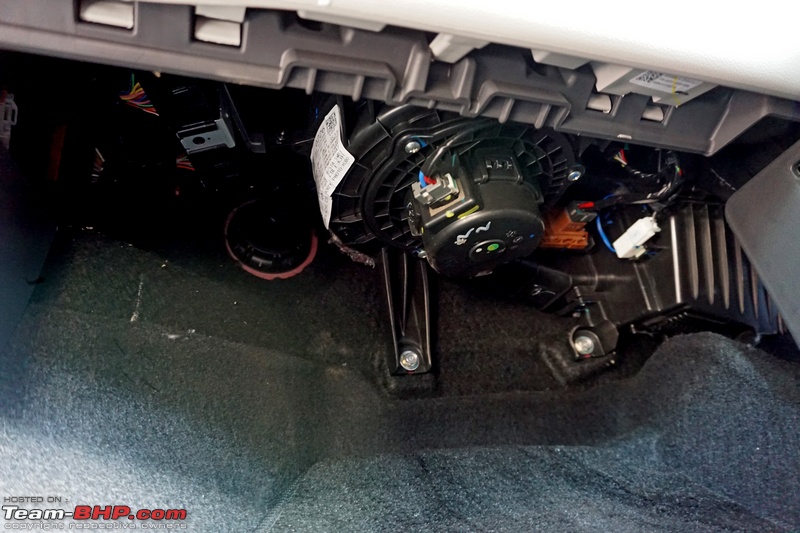 Last edited by Aditya : 20th May 2020 at 14:15. |
| |  (24)
Thanks (24)
Thanks
|
| The following 24 BHPians Thank blackwasp for this useful post: | akshay81, CarguyNish, CrAzY dRiVeR, espraveen, Gannu_1, GTO, InControl, John316_WRC, keroo1099, lemedico, libranof1987, Obi-Wan, Omkar, RavenAvi, Reinhard, Sachin V.W., searacer932, Simat, smuniswami, TROOPER, Ultim8, vaish9925, vb-saan, Venkatesh |
| | #5 |
| Senior - BHPian | Interior - Rear The rear doors of the Aura open and close in a two-stage action. They open wide enough and the roof does not slope down as sharply towards the rear like some other cars. This is because the C-pillar is more upright than in other sedans. The rear seat is placed slightly lower than we would like and like most other compact sedans, you have to "sit down" in it:  Wide gap between the B-pillar and the bench makes it easier to step in & out:  No scuff plates or sill protectors provided:  Like the front, the rear doorpads get an ivory and black colour theme. Note that the lighter shade is relegated to a smaller area at the bottom as compared to the front doorpads. At the bottom means it will easily soil from passenger's shoes:  A 1L bottle and some knick-knacks can be accommodated in the door pocket. It isn't as long as the front unit and its carrying capacity is limited to smaller items:  Door handle can double up as a storage space. Note the exposed screw. Looks bad:  Rear bench gets a bit of a contoured seatbase, but is flat overall. The seat is placed low and even medium-height occupants would find the under-thigh support lacking (shorter folk should be okay). The low seats ensure there is adequate headroom as the roof slopes downward - at 6 feet, I had about an inch of clearance to the roof / rear windshield:  There is decent space for 4 adults in this car. GTO (5'10") could sit behind his own laid-back driving position (not the case with many budget cars). However, cabin width is limited. The Aura is not a sedan in which you can take 3 healthy adults in the back seat for a long drive - it is good for 2 and a kid. Additionally, the seatbase is raised in the middle where the third passenger sits. This means he has lesser headroom than the side occupants; no headrest for him either:  Middle passenger gets a lap belt. Seatbelt buckles do not get dedicated cutouts in the rear seat:  A look at the maximum and minimum legroom available:  The seatbacks of the front seats are slightly scooped out & soft, making things that much better for the rear passengers:  There is adequate space below the front seats for your feet:  The headrests are soft and adjustable, but have only two positions - all the way up or all the way down (nothing in between):  The center armrest is positioned at a comfortable height. It is wide & soft, and comes with two cupholders:  ISOFIX child seat anchors have been provided on both sides. They are a standard feature in all variants of the Aura:  Parcel tray is flat, but can't be used to store anything on it. It slopes down and there is no lip to prevent items from rolling onto the rear seat. This is a good thing as keeping things here will block the driver's rear view:  Anchor points for the top tether of the child seat are provided on both sides:  Neat plastic flaps keep them concealed when not in use. Typical Hyundai attention-to-detail, even in a budget sedan:  Overall glass area is healthy. There's enough light coming in at the back and the light shade used on the upper part of the interiors ensures that passengers don't feel claustrophobic. On the flip side, short passengers / kids will find the upward sloping window line to be restricting:  Rear window can be rolled down all the way:  Seatback pocket only for the left side passenger. It is wide and fairly deep. Why Hyundai couldn't give it on both seats is beyond us:  Rear air-con vents are provided on all, except the E (base) variant. While there is only one common air volume controller, their direction can be adjusted individually. The rear air-con works well. For passengers, it makes a noticeable difference. Like all Hyundais, the plastic used feels good:  12V power outlet sits below the rear air-con vents. No USB port for rear passengers to use (buy a converter online):  Fixed grab handles only, no spring-loaded units in the Aura. No coat / bag hook either:  Roof gets a whitish-grey liner which lends a feeling of roominess inside the cabin:  Nifty cabin light is placed bang in the middle. It is identical to the one at the front with the usual 3 positions ("on", "door" and "off"). It goes off with a theatre dimming effect:  Floor hump is about 3 inches high and wide. This, and the air-con unit, will restrict legroom for the middle passenger & annoy him. It will be best for him to place his feet on either side of the floor hump:  402-liter boot is slightly smaller than the Xcent's (407 liters). The boot is larger and more usable than the Dzire's (378 litres), but smaller than that of the Amaze (420 liters) and Tigor (419 liters). It features a full carpet and looks well finished. The opening is fairly wide, but the loading lip is high, which makes it a bit inconvenient to load luggage. The family's weekend luggage will easily fit in here. Nope, the rear seat doesn't fold down:  Boot lid is naked on the underside with large gaping holes - looks awful. This is a common sight in most cars in the segment, but we expected better from Hyundai. As mentioned earlier, the boot lid has some weight to it and doesn't feel as tinny as say, the Dzire:  Exposed locking mechanism with wires coming out of it looks cheap:  That said, the exposed underside does allow for a quick change of a bulb if needed:  Useful boot lamp:  A rather uneven, unfinished gap (by Hyundai standards) to lift the boot floor up:  Tools are housed in a soft bag, which sits in the spare wheel. Spare wheel in all trim levels is a 14-inch steel piece shod with a 165/70 section Ceat Fuelsmart tyre. The higher variants should definitely have gotten a spare of the same size as the regular wheels. When using a thinner space saver, remember to drive very cautiously (due to the varying tyre sizes). The bean counters surely have more influence at Hyundai than they did 5 years ago:  As the spare tyre is placed towards the front part of the boot, there is sufficient space to keep some other stuff (extra fluids, car cleaning kit, etc) in the wheel well:  Pouch to store the warning triangle gets Velcro strips at the back to prevent it from sliding about: 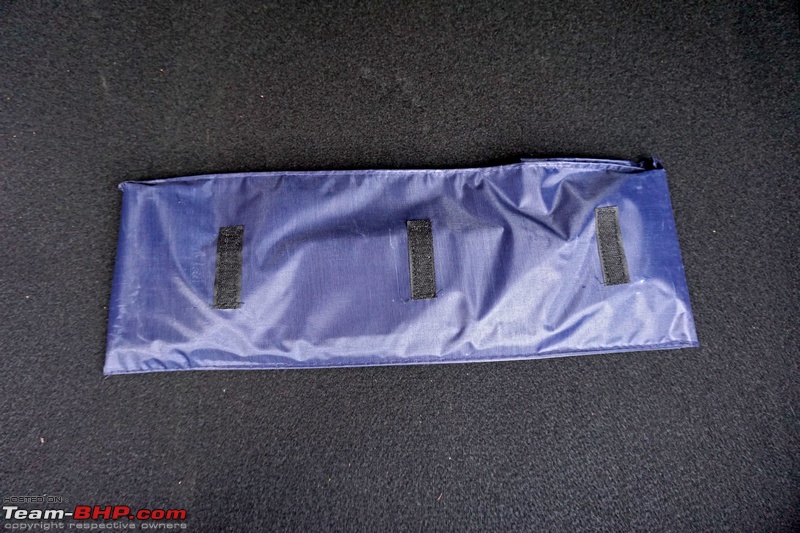 Last edited by GTO : 19th May 2020 at 09:31. |
| |  (21)
Thanks (21)
Thanks
|
| The following 21 BHPians Thank blackwasp for this useful post: | akshay81, ast.ggn, CrAzY dRiVeR, espraveen, Gannu_1, GTO, InControl, keroo1099, libranof1987, Obi-Wan, Omkar, Ponbaarathi, RavenAvi, Reinhard, Sachin V.W., Simat, TROOPER, vaish9925, vb-saan, Venkatesh, warrioraks |
| | #6 |
| Senior - BHPian | Driving the 1.0L Turbo-Petrol MT Turbo GDI engine gets a host of technical innovations. It's quite a compact motor, and has its exhaust manifold integrated into the block:  The Aura petrol is powered by Hyundai’s in-house developed 998cc, 3-cylinder turbocharged engine. It's called the Kappa 1.0 Turbo GDI and gets a direct-injection fuelling system, electronic wastegate actuator, variable oil pump, oil spray jets for the pistons from the crank side and dual variable valve timing. The same is offered in the Grand i10 Nios. It is also used to power the Venue in a higher 118 BHP state of tune (note: Aura & Venue have the same 172 Nm torque though). The other 3-cylinder 1.0L turbo-petrols we've driven in India are the now discontinued EcoSport (EcoBoost) & Baleno (BoosterJet). Hyundai's 1.0 is decidedly superior to those. The 1.0L petrol produces a strong 99 BHP (@ 6,000 rpm) and 172 Nm (@ 1,500 - 4,000 rpm). Both - the power figure as well as the torque rating - put it well ahead of its direct rivals. While its power is 5 - 15 BHP higher than competitors, the Aura's torque advantage is a whopping 50-60%! Therefore, it's terrible that this sweet turbo-petrol is available in just a single variant, the SX+. It's also sad that the Aura doesn’t get the 1.0L & dual-clutch AT combination of the Venue. Instead, the lineup has the familiar 1.2L petrol with an AMT. Hyundai has lost out on a crucial advantage as it could have offered a smooth DCT versus the Dzire's jerky AMT. The Koreans are probably worried about cannibalisation between the Aura & Venue. Well, if you don't cannibalise yourself, someone else will gladly do it for you. With a kerb weight of just 900 kg, the Aura is lighter than all sub-4 meter sedans, except the Maruti Dzire. It has a class topping power-to-weight ratio of 110 BHP / ton and a torque-to-weight ratio of 191 Nm / ton!! To put that into perspective, the Dzire's torque-to-weight ratio is 128 Nm / ton. Heck, these ratios are even higher than the 118 BHP Venue's (which weighs ~200 kilos more) & Verna 1.6. As you might have guessed by now, there is more than enough performance available to keep drivers happy  . . To start the engine, you need to press the clutch and then hit the engine start button. At idle, it is decent for a triple cylinder, although enthusiasts like us will notice mild vibrations (there is mild cabin shake when cranking too). It’s not like other 4-cylinder Hyundais (e.g. i20) where you can’t even tell if the damn engine is running. On the move, the refinement is impressive! Not many will be able to tell that the engine is missing a cylinder. The Aura moves off from a standstill in a clean manner. Despite the high power output from such a small turbo-petrol, driveability is satisfactory. In fact, the car clears the second gear speed breaker test. Some lag is there of course, yet it's minimal & well-controlled. Overall city behaviour is decent and the engine does the job as long as the rev counter is 1,000+ rpm (drop lower and you need to downshift). The turbo petrol is pretty peppy and fast. Throttle response is not the sharpest, but it's fair. As you rev the engine, there is a nice tug from the turbo. Cross 2,000 rpm and the 1.0L engine comes into its powerband. Keep the motor on the boil and it will reward you with satisfying performance. That, clubbed with the small footprint + light steering, makes the Aura a fine city sedan. On the open road, Hyundai’s turbo-petrol is simply fantastic! We loved high-revving this little 1.0. It’s fast, has a punchy mid-range and good refinement for a triple cylinder. The mid-range, in particular, is lots of fun. This engine should be your top choice if you're looking at an Aura petrol. Keep the revvs high, work the gearbox and she transforms into a fast expressway cruiser. Trivia = 2nd gear is so tall that the Aura is a rare budget car that can hit ~108 km/h in 2nd gear itself! This also means that the 2nd gear is genuinely usable from 0 km/h right up to 108 km/h. The engine revvs till 6,600 rpm, which we found to be a little low for a petrol. This rev limit can sometimes catch you out in the middle of an overtaking maneuver. When cruising, the car sees 100 & 120 km/h at ~2,100 & ~2,500 rpm respectively. These are neat numbers for a small petrol. Highway driveability is good and you won't find the need to downshift often, although there is some lag in the higher gears. Thus, while passing slow moving vehicles on undivided highways, it is better to downshift, use the mid-range and fly past them. All in all, Hyundai's 1.0L is the best-in-segment offering. In stop-and-go traffic on steep hills, turbo-lag can sometimes catch you out. You'll need careful A-B-C pedal co-ordination in such conditions. We didn't feel this in the Venue because its equipped with hill start assist. The gearbox is light, smooth & sure-slotting. Do note that the Aura has a 5-speed MT, and not 6 like the Venue. While the clutch is light, we found its travel range to be on the longer side for a small petrol sedan. Coming to NVH levels, the Aura does very well at slow speeds and around town - the cabin has excellent insulation. You shut the door / windows and exterior sounds are noticeably reduced. There’s almost no engine sound heard in the cabin if you're driving in a calm manner. Even while cruising on the highway, the engine is silent enough. Upon revving, you can hear that familiar 3-cylinder thrum though. What we appreciated is that the engine actually sounds nice when revved hard. Enthusiasts will like it, but not regular folk as things get l-o-u-d above 5,500 rpm. Wind noise is minimal at 100 km/h, while road and tyre noise are par for the course. In terms of fuel economy, the Aura turbo petrol carries an ARAI rating of 20.50 km/l, which is behind the 23.26 km/l benchmark set by the Dzire. Small + high power + turbo petrol engines don't usually deliver impressive FE numbers (just ask EcoSport EcoBoost owners). We'll wait for actual city & highway figures from Aura-owning BHPians. 998cc turbo-petrol engine develops 99 BHP & 172 Nm. That's 19 BHP lesser than the Venue, but with the same torque. Assuming the hardware is basically the same, you will literally "fly" with a remap that gets you the Venue's 118 BHP. No 'Turbo GDI' marking on the engine cover like the Venue:  No insulation sheet under the bonnet of the petrol. This one doesn't need it:  No underbody protection. You can see the ground below clearly:  Turbocharger sits at the back of the engine:  Vertically-stacked intercooler:  Smooth & sweet 5-speed MT. Reverse is located up, to the extreme left:  To engage reverse, pull the black unlock button upwards:  Evidence of part-sharing between Hyundai and Kia. Hose pipe...  ...and connector have Hyundai and Kia markings. There are many more if you go looking for them:  Last edited by GTO : 19th May 2020 at 09:30. |
| |  (29)
Thanks (29)
Thanks
|
| The following 29 BHPians Thank blackwasp for this useful post: | akshay81, CarguyNish, CrAzY dRiVeR, espraveen, Gannu_1, GTO, InControl, jithin23, John316_WRC, keroo1099, libranof1987, Obi-Wan, Omkar, PGNarain, Ponbaarathi, Prakritij, RavenAvi, Reinhard, Sachin V.W., Simat, smuniswami, ssoni.1411, TROOPER, vaish9925, vb-saan, Venkatesh, VijayAnand1, VTec_KickedInYo, warrioraks |
| | #7 |
| Senior - BHPian | Ride & Handling The Aura uses a McPherson strut suspension with coil springs at the front and a coupled torsion beam at the rear. Low speed ride quality is compliant, with small bumps being absorbed well. However, it's not plush. There is a bit of a firm edge to the ride than what we expect in Hyundais. The tune is more mature than the usually soft suspension of Hyundai cars. Ride comfort overall is fine for a budget sedan, but bad roads are felt and large potholes come in strong. There is a little more side-to-side swaying on broken roads too (don’t generally see this with low sedans). Do note that lesser variants with their smaller wheels + taller tyre sidewalls will be cushier. On the other hand, because of the more mature suspension, high speed ride quality is better than your typical Hyundai. The car feels quite comfortable on the expressway & the rear end doesn’t bounce about excessively either. The Aura is more planted than the Xcent, with the firmer suspension recovering well from road undulations. On the highway, the Aura handles imperfect roads fairly well & tackles smaller potholes with ease. Straight line stability at 100 - 120 km/h is acceptable. She can cruise at triple digit speeds without feeling nervous at all. In the area of handling, the Aura remains neutral, just as you'd expect of a family sedan. There is some body roll, yet it's controlled since the suspension isn't too soft. However, the car's 175/60 MRF ZVTV tyres are too thin for the turbo-petrol (this flagship engine should have gotten 185 / 195 mm tyres). The car understeers easily if pushed, with the tyres giving up much earlier than the car does. Because of the thin tyre size & rubbish MRF ZVTV Ecotred budget rubber, getting the tyres to squeal is easy. BHPians should most definitely procure 185 / 195 mm tyres from a superior brand; it's not a want, but a need. Will also lead to superior ride comfort. The electric power steering is typical Hyundai - super light at parking speeds, light enough at city speeds & weighs up alright on the highway. Along with the compact footprint, the light steering makes the Aura an extremely easy car to drive in the city. Its turning radius of 4.7 meters is as tight as the Honda Amaze's and smaller than that of the Maruti Dzire. On the highway, at high speeds, the steering weighs up adequately. Enthusiasts won't find its feel & feedback to their tastes. Overall though, this steering is far better than what we’re seeing in the newer Marutis. The ground clearance is rated at ~163 mm. While we didn't scrape over any bumps, we didn't load the car up with 4 passengers & luggage either. Team-BHP ownership reports will tell us the real-world story. All variants of the Aura come with disc brakes at the front and drums at the rear, with ABS + EBD. The brakes perform as expected. However, the pedal travel before the brakes bite is a little longer than you expect. It's not a problem, but takes 3 - 5 km to get used to. Last edited by GTO : 19th May 2020 at 09:29. |
| |  (27)
Thanks (27)
Thanks
|
| The following 27 BHPians Thank blackwasp for this useful post: | akshay81, anshuman1117, ast.ggn, CrAzY dRiVeR, espraveen, fiat_tarun, GTO, InControl, keroo1099, libranof1987, Nazaar25, Obi-Wan, Omkar, Ponbaarathi, Prakritij, RavenAvi, Sachin V.W., Simat, supertinu, TROOPER, Ultim8, vaish9925, vb-saan, Venkatesh, VTec_KickedInYo, warrioraks, YashD |
| | #8 |
| Senior - BHPian | Other Points • To see how this car did vs the others in a Team-BHP member poll, click here. • Due to the outbreak of the Covid-19 pandemic, we were unable to call for the other variants (diesel, 1.2L petrol, AMTs). We've reviewed the 1.2L MT petrol often in other Hyundai reports, so you can look those up. And while Hyundai's AMT cannot match the DCT, it is far more liveable & smoother than Maruti / Tata AMTs. CrAzY dRiVeR & Chetan_Rao drove the diesel at the media drive. They state that the refinement is good by 3-cylinder standards, although mild vibrations (steering, pedal) & some clatter is present. The 1.2L diesel has linear acceleration, but no punch when the turbo kicks in. Good city driveability. Its power figures suggest that expressway performance will be commuter-like and ordinary. Small size + less power + 3 cylinders will ensure high fuel economy. • Apart from the 1.0L turbocharged petrol engine, the Aura is offered with a 1.2L naturally-aspirated engine, a CNG version of the same and a 1.2L diesel. An Automated Manual Transmission is offered on the 1.2L petrol and 1.2L diesel. • Available in 5 variants - E, S, SX, SX+ & SX(O). Turbo-petrol is available only in the SX+ variant, while the CNG kit is available only in the S variant. Diesel MT is offered in S and SX(O) variants, while the petrol AMT & diesel AMT come in S and SX+ variants. • Apart from the Fiery Red colour of our review car, the Hyundai Aura is available in Vintage Brown, Alpha Blue, Titan Grey, Typhoon Silver and Polar White shades. The 1.0L turbo petrol is available only in Fiery Red (our choice), Typhoon Silver and Polar White. • The red highlights are exclusive to the 1.0L turbo petrol. • The Hyundai Aura has been developed at a cost of Rs. 800 crore and is over 90% localised. • While the automatic transmission and turbo-petrol variants aren't available in the SX(O) trim level, they don't really miss out on much. Only stuff like a leather-wrapped steering wheel, gear knob and cruise control are missing. • Very sad horn, Hyundai should have given the Aura a more powerful dual-tone unit. • Don’t know what’s up with Hyundai & bugs. In the Venue test car we had, the Bluetooth mic wasn’t working and in this Aura test car, the wireless charging pad wasn’t working. Tested with a Samsung S9 as well as the latest iPhone. In both the cases, the charging started, but stopped after 1 – 2 minutes (despite the phones being in the 60 – 80% charged range). Hyundai had better control these quality lapses before they get out of hand. We've never seen these niggles in earlier Hyundais. • The Aura is a departure from the 5-letter naming convention of the typical Hyundai line-up (Creta, Elite i20, Grand i10, Verna, Venue and Xcent). The Santro was an exception and so were international models like the Sonata or Tucson. • Standard warranty can be selected by the owner amongst the following - 3 years / 1,00,000 km, 4 years / 50,000 km or 5 years / 40,000 km. Extended warranty up to 5 years / 1,40,000 km can be purchased. We strongly recommend purchasing the maximum possible coverage available. • First service visit is at 1,500 km / 2 months (just a checkup), second at 10,000 km / 12 months. Subsequent services after every 10,000 km / 12 months. • ARAI-certified fuel efficiency: Petrol 1.0 and 1.2 = 20.5 km/l; Petrol AMT = 20.1 km/l; Diesel MT = 25.35 km/l; Diesel AMT = 25.4 km/l. • Doors auto-lock at 15 km/h. All doors automatically "unlock" when the engine is switched off. As much as we're fans of auto-locking, we hate any kind of auto-unlocking. Our country is too crime-prone for that. • Try to unlock the doors while driving and you'll face a lot of resistance. The locking knob fights back aggressively! Cool safety feature. • On setting off without buckling up, the seatbelt warning light in the instrument cluster starts blinking. A warning chime accompanies it. Even if you stop and put the car in P, the light keeps blinking and the chime keeps playing. Despite such measures & more, 75% of drivers in India don't buckle up - related thread. Manufacturers are trying hard, yet the masses simply lack common sense! • Even with the ignition off, you can electrically fold in / out the door mirrors. Thoughtful. • The Hyundai Aura brochure can be viewed here - Aura.pdf. • Disclaimer : Hyundai invited Team-BHP for the Aura test-drive. They covered all the travel expenses for this driving event. Last edited by Aditya : 27th May 2020 at 11:44. |
| |  (32)
Thanks (32)
Thanks
|
| The following 32 BHPians Thank blackwasp for this useful post: | akshay81, ast.ggn, AYP, CrAzY dRiVeR, espraveen, fiat_tarun, Gannu_1, GTO, InControl, Nazaar25, NTO, Obi-Wan, Omkar, Ponbaarathi, RavenAvi, Reinhard, Sachin V.W., SatishBisht, Simat, Simhi, smuniswami, ssoni.1411, Subby, supertinu, tharian, TROOPER, Ultim8, vaish9925, vb-saan, Venkatesh, VTec_KickedInYo, warrioraks |
| | #9 |
| Senior - BHPian | The Smaller yet Significant Things Front wheel wells get full plastic cladding:  No such love for the rear wheel wells. Just a thin rubberised coating:  Yikes!! No labelling on the fuel flap or cap indicating the car's diet. The fuel cap doesn't even get a string to keep it attached to the base. Please ensure that the fuel pump attendant fills the right fuel in your Aura; someone mistakenly putting diesel will destroy the high-tech turbo petrol motor:  Aura gets a 37L fuel tank which is the same size as the Maruti Dzire. While the Tata Tigor and Honda Amaze have smaller tanks (35L each), the Ford Aspire gets a larger 42L unit (40L for the diesel):  Projector halogen headlamps have a good throw and light up the road ahead sufficiently:  High beam performance is, however, just adequate:  ORVMs are India friendly and will move the other way if a biker side-swipes them:  Recommended tyre pressures are 35 PSI at the front and 33 PSI at the rear for all tyre and load combinations. No doubt, this higher tyre PSI is a contributor to the firmness felt in the ride:  VIN is lightly engraved on a beam, below the driver's seat:  MID has a gearshift indicator. Newbies will appreciate. It shows which gear you should shift to in order to obtain the best fuel economy (not just up or down arrows). As an example, if you are in 3rd and revving hard, it will tell you to shift straight to 5th!  You can keep the rear camera permanently on while driving. I found it pretty handy, especially with rear seat occupants blocking the view through the IRVM. GTO didn't think too much of this:  Weirdly, the said display does not work with the handbrake engaged:  Engage reverse gear and the MID shows an 'R', along with the parking sensor display:  Last edited by GTO : 19th May 2020 at 09:38. |
| |  (37)
Thanks (37)
Thanks
|
| The following 37 BHPians Thank blackwasp for this useful post: | akshay81, ast.ggn, AYP, CrAzY dRiVeR, espraveen, fiat_tarun, Gannu_1, GATMNEAR, Goku_YNWA, GTO, icar, InControl, jithin23, jnanesh, Karthik Chandra, keroo1099, Keynote, lemedico, libranof1987, Omkar, Paavan Shetty, Ponbaarathi, Prakritij, RavenAvi, Reinhard, Sachin V.W., Simat, smuniswami, ssoni.1411, sv97, The Rationalist, TROOPER, Ultim8, vaish9925, vb-saan, Venkatesh, VTec_KickedInYo |
| | #10 |
| Team-BHP Support  | Re: Hyundai Aura : Official Review Thread moved from the Assembly Line to Official Reviews. Thanks for sharing! Top-class review of a top-class car. Rating 5 stars  . . On an early Sunday morning, I picked up the keys and took the Aura to Lonavla. Was expecting a usual “commuter sedan” kind of experience and braced myself for a relaxed drive. Holy cow, was I in for a surprise. The 1.0 flies on the open road  ! This turbo-petrol is now my top choice among petrol compact sedans. As an engine-focused guy, I believe what's under the hood makes or breaks the car and this motor is easily the best in the segment (by far). Sure helps that the car is otherwise competent too - best in class quality and improved road manners (mature suspension by Hyundai standards). Not without flaws; bad roads did bother me & the car, while Hyundai really needs to upgrade its ICE. That low-powered diesel also seems to have outdated power ratings. ! This turbo-petrol is now my top choice among petrol compact sedans. As an engine-focused guy, I believe what's under the hood makes or breaks the car and this motor is easily the best in the segment (by far). Sure helps that the car is otherwise competent too - best in class quality and improved road manners (mature suspension by Hyundai standards). Not without flaws; bad roads did bother me & the car, while Hyundai really needs to upgrade its ICE. That low-powered diesel also seems to have outdated power ratings. When it comes to diesels, the Amaze Diesel CVT is my top choice. Honda's engine + AT combination is unbeatable in this sea of jerky AMTs. Got back home, parked, looked at its ugly rear and smiled. The drive was satisfying (link to my drive report): 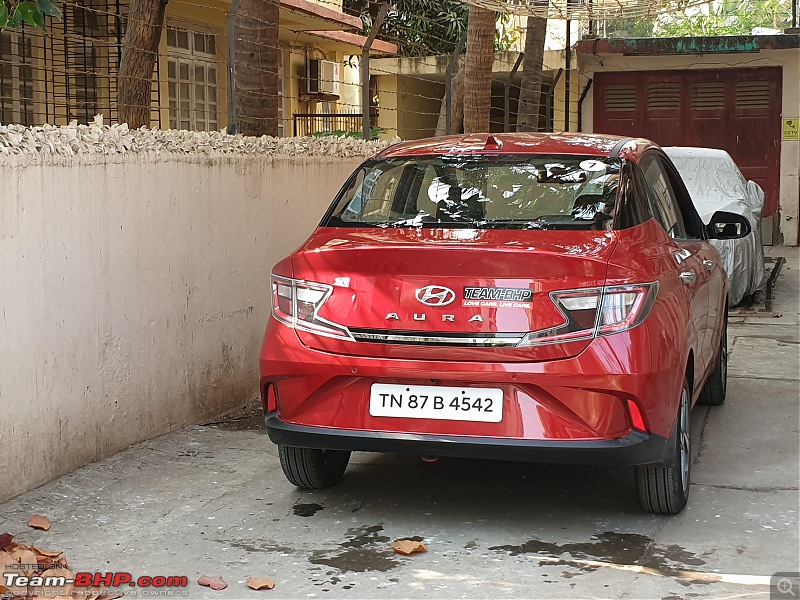 Last edited by GTO : 19th May 2020 at 10:03. |
| |  (35)
Thanks (35)
Thanks
|
| The following 35 BHPians Thank GTO for this useful post: | 2himanshu, akshay81, ashvek3141, ast.ggn, AYP, blackwasp, CarguyNish, CrAzY dRiVeR, deep_behera, Gannu_1, GATMNEAR, Goku_YNWA, haisaikat, InControl, Keynote, libranof1987, Nazaar25, noopster, NTO, Paavan Shetty, Ponbaarathi, RavenAvi, Reinhard, Sachin V.W., ssoni.1411, sv97, tharian, The Rationalist, TROOPER, turbowhistle, vb-saan, Venkatesh, vishy76, VTec_KickedInYo, warrioraks |
| | #11 |
| Senior - BHPian Join Date: May 2013 Location: Mumbai
Posts: 1,576
Thanked: 6,447 Times
| Re: Hyundai Aura : Official Review The rear three quarters is very similar to the Dolphin city in my view. Have a look at them side by side and you will know what I am saying. |
| |  (5)
Thanks (5)
Thanks
|
| The following 5 BHPians Thank 2000rpm for this useful post: | Goku_YNWA, GTO, InControl, IndigoXLGrandDi, Karthik Chandra |
| |
| | #12 |
| Team-BHP Support  | Re: Hyundai Aura : Official Review As a previous generation Xcent AT owner - I went for the Aura drive knowing what to expect - uglier looks, refined engine, good interiors, and material quality, decent boot space, dead steering, bouncy rear, and an overall boring drive. The drive event even came soon after I completed a ~500kms road trip in our Xcent. But - the drive was anything but expected. For starters - the turbo petrol motor can go from all the way from 0 kmph (with a little bit of clutch slipping) all the way to 108 kmph! Shift hard from 1st to 2nd gear in the peak of the midrange - and there is a good amount of wheelspin and torque steer as a result. Power delivery is much peppier than the 1.2 petrol and this is clearly the engine of choice for the Aura. The rear suspension is a lot more mature than the Xcent as well! You get tossed up and down in the Xcent at highway speeds - but the Aura is a lot more neutral. The turbo could have received a sportier suspension - but then, that isn't the target audience for the car. i10 Nios would also be an interesting option for BHPians, who miss an entry-level turbo-petrol option after the exit of the Tiago JTP. I would really like to see what Hyundai plans to do with the next generation i20. They have the engine, they have the localization now - the 1.0 is shared with cars from i10 Nios to Verna, and they have the brand - N Line. All it needs is a better suspension and heavier steering feel! Interior colour scheme of the non-Turbo variants: 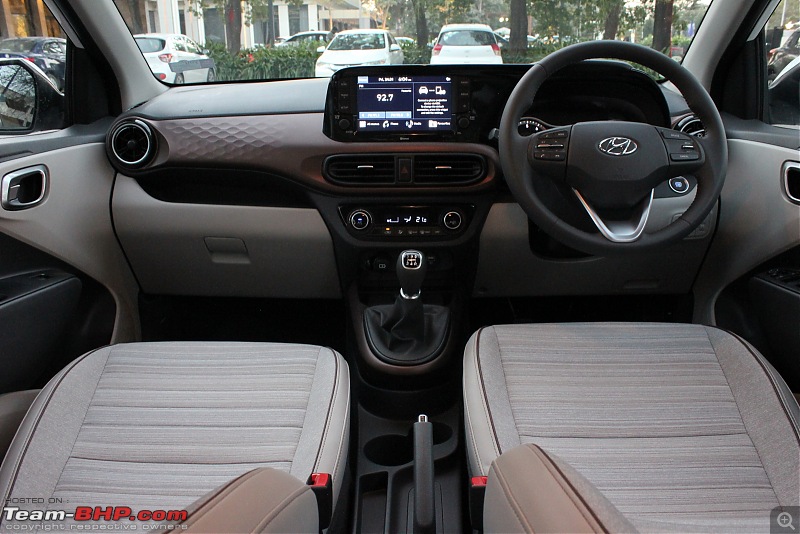 A closer look at the dashboard texture in the non-Turbo variants. Reminds me of my copper water bottle, though this looks good in black on the Turbo variant. 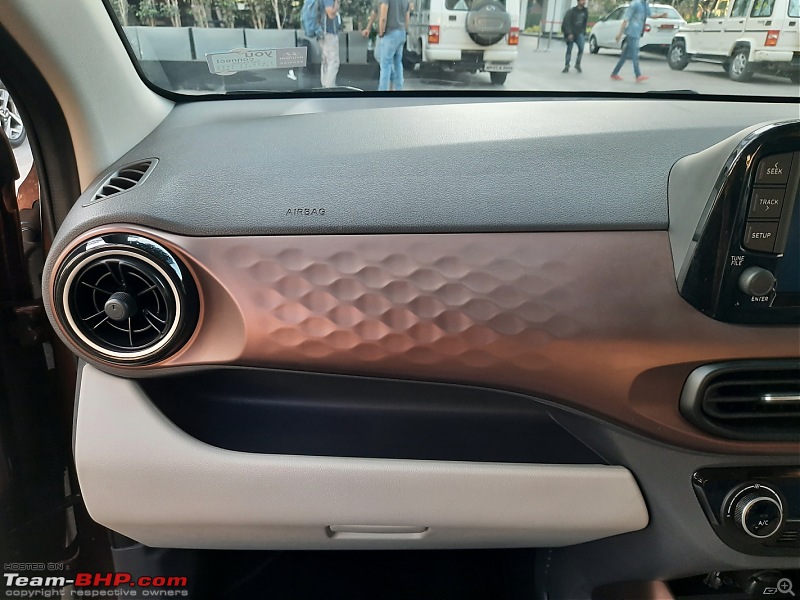 Ivory seats of the non-Turbo variants will be a pain to maintain: 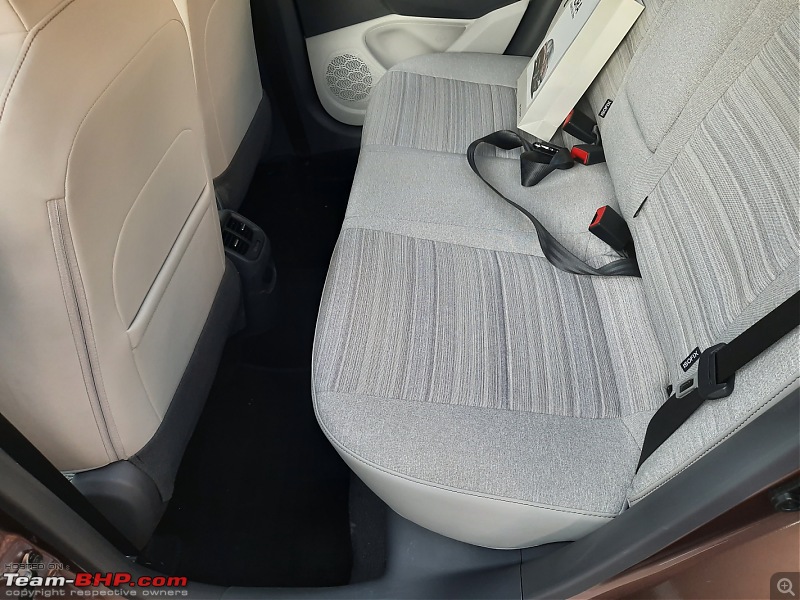 The various colours on offer. Polar White - 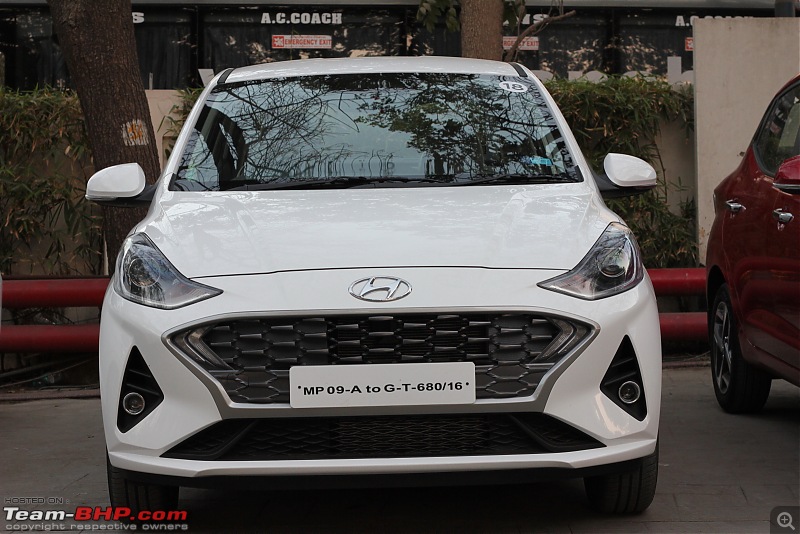 Alpha Blue - 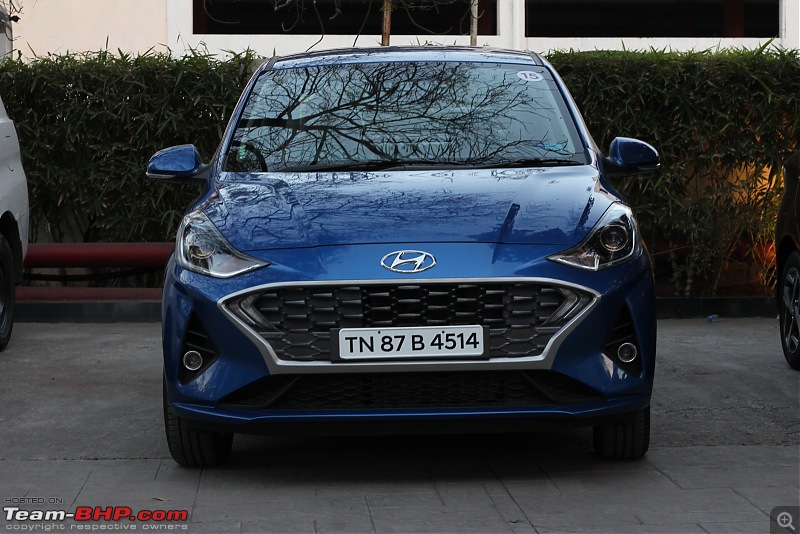 Vintage Brown - 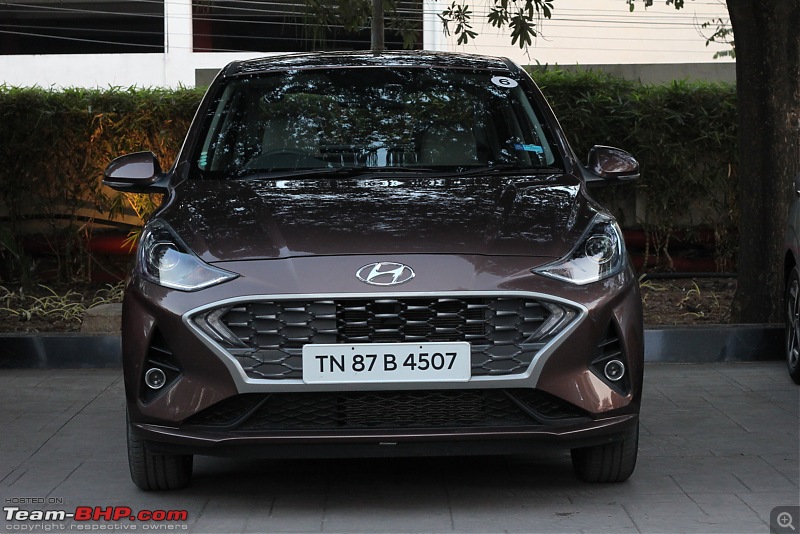 Typhoon Silver - 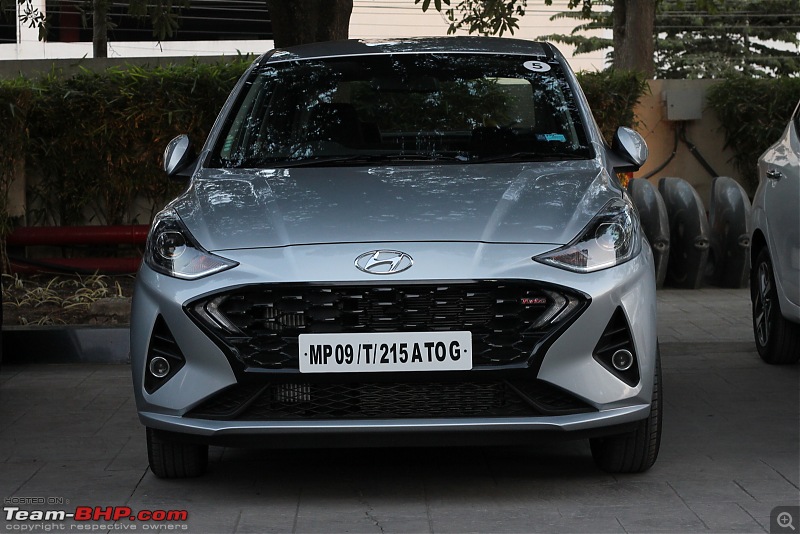 Fiery Red - 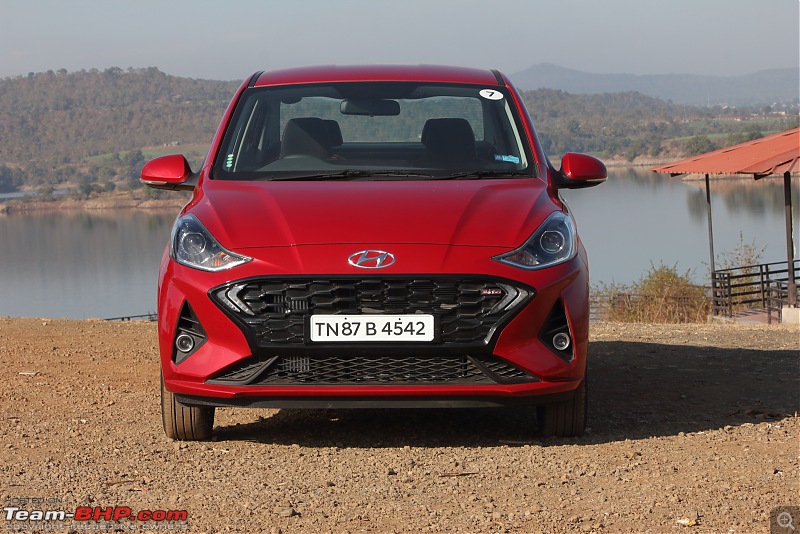 Last edited by CrAzY dRiVeR : 19th May 2020 at 10:53. |
| |  (33)
Thanks (33)
Thanks
|
| The following 33 BHPians Thank CrAzY dRiVeR for this useful post: | 2himanshu, akshay81, ast.ggn, blackwasp, CarguyNish, catchjyoti, DrANTO, Gannu_1, GTO, haisaikat, icar, InControl, Karthik Chandra, Keynote, Nazaar25, NTO, PGNarain, Ponbaarathi, Prakritij, RaceHorse, RavenAvi, Reinhard, Sachin V.W., Simat, supertinu, The Rationalist, Torque_Curve, TROOPER, Ultim8, vb-saan, Venkatesh, VTec_KickedInYo, warrioraks |
| | #13 | |
| Distinguished - BHPian  | Re: Hyundai Aura : Official Review Quote:
Trust me - you guys (the whole reviewer team) - literally sell cars for these car makers just by your photographic skills! The way you folks capture details is unmatched. I have never seen photos elsewhere that actually also capture the "material quality" of the objects in the frame. Kudos to you guys for this. I don't mind a busy rear (heck I own a Nexon, that is the pinnacle of freedom of expression literally!) but in case of the Aura - it doesn't look like its "designed" at the rear at all. It looks like its put together with surplus parts found lying around in the studio. Of the cars currently on offer in the segment - this one surely has the worst integration of the boot. The silly black cladding, chrome and appliques only make it worse. That's my grime. Its either designed by someone with a learner's certificate OR they have intentionally designed it this way to ensure people don't like it too much & also look at other cars in the showroom - i.e. i20 which they also want to sell. I don't like the i10 NIOS either because of its overdone front which is not to my taste. I used to like the previous Grandi10. A balanced and smooth on the eyes design that one. But then - Hyundai has carpet bombed the segment using the AURA's features. The feature list is jaw dropping. Talk of throwing the kitchen sink at the Dzire. And so is the engine & gearbox combination on offer. There is an option for absolutely everyone. Hyundai is really doing well in giving good options to pick and choose for customers. The sheer list of equipment and feature list available on offer might very well make customers forget about the polarizing design externally. I'm sure that's what Hyundai is betting on. I wish the car had adjustable front head restraints, twin-horns. And yes - a sticker to tell the fuel attendant about what to fill along with a little plastic tag to hold the opened cap.  Especially when the car has a tiny detail like air volume controllers for the front AC vents. I don't remember when was this feature available on a budget segment car last! I suspect the DZIRE will still not face much of a challenge simply due to the loyalty that brand plate commands. But full marks to Hyundai for making a rather well rounded and packaged car in a segment that is pretty much owned by MSIL. One question - how is the rear seat back recline angle? I generally have no problems in any mode of transport (its built that way in our Indian DNA thanks to crowd). I have been totally comfortable even when travelling on the mud guard of a farm tractor for few hours. But - the erstwhile XCENT happens to be the only car that made me noticeably uncomfortable even when travelling alone in the rear seat. The recline angle was rubbish in that car. It was as if its made to let you sleep, but then the sideways swaying of the car never lets you fall asleep either! Last edited by Reinhard : 19th May 2020 at 11:30. Reason: typo | |
| |  (15)
Thanks (15)
Thanks
|
| The following 15 BHPians Thank Reinhard for this useful post: | anshuman1117, blackwasp, BZ25, GrammarNazi, GTO, InControl, murajith, Nazaar25, RavenAvi, RoverX, Sachin V.W., TROOPER, Venkatesh, VijayAnand1, warrioraks |
| | #14 |
| BHPian Join Date: Nov 2019 Location: Gurgaon
Posts: 204
Thanked: 948 Times
| Re: Hyundai Aura : Official Review Podgy styling aside, a decent effort from Hyundai, building on the strengths of its predecessor, the Xcent. I recall sitting in a taxi-spec Xcent, and boy, for the price, interior quality was nothing short of excellent, so one can expect the Aura to do well here too, since it's more of an evolution than revolution. Why did Hyundai give it so weird styling though, especially from the rear? It just looks hideous, but it may just appeal to the masses who love bling and this is probably part of Hyundai's design strategy- to create polarizing designs, loved by one & hated by another, just look at the new Creta!  But I do appreciate Hyundai for bringing in the excellent 1.0l Turbo Petrol from the Venue, though I'd go for the lighter turbo Grand i10 NIOS rather than the Aura, but for someone who wants a relatively practical and fast Petrol compact sedan, this is an excellent option. Ford missed a big one here, it could have easily married the Aspire & Figo to the 1.0 Ecoboost Petrol, it would've been a hoot to drive and much better than the average 1.2l Naturally aspirated engine. But I do appreciate Hyundai for bringing in the excellent 1.0l Turbo Petrol from the Venue, though I'd go for the lighter turbo Grand i10 NIOS rather than the Aura, but for someone who wants a relatively practical and fast Petrol compact sedan, this is an excellent option. Ford missed a big one here, it could have easily married the Aspire & Figo to the 1.0 Ecoboost Petrol, it would've been a hoot to drive and much better than the average 1.2l Naturally aspirated engine. Dear Hyundai, why don't you introduce the Turbo Petrol in the top variant and why does a 9 lakh car have fixed front headrests, please start giving some importance to safety.  That said, I hope that the Aura will score well in terms of safety, as safety is in the need of the hour, when it comes to the Indian Car Market. That said, I hope that the Aura will score well in terms of safety, as safety is in the need of the hour, when it comes to the Indian Car Market.Last edited by suhaas307 : 27th May 2020 at 18:58. Reason: Minor spacing |
| |  (4)
Thanks (4)
Thanks
|
| The following 4 BHPians Thank BZ25 for this useful post: | anshuman1117, blackwasp, InControl, Reinhard |
| | #15 | |
| Senior - BHPian Join Date: Dec 2019 Location: Bengaluru
Posts: 1,055
Thanked: 3,721 Times
| Re: Hyundai Aura : Official Review Excellent review as always. The car seems fine but I don't like Hyundai limiting the color choices on the turbo variant. Silver would be my pick from the available ones. Red just stands out too much (especially at the back with the weird chrome strip). It was always expected that the 1.0 turbo petrol + DCT would be limited to the Venue and i20 in the Hyundai line up so that is not a disappointment as such. One thing I am not sure of is this part of the review: Quote:
| |
| |  (4)
Thanks (4)
Thanks
|
| The following 4 BHPians Thank JithinR for this useful post: | anshuman1117, blackwasp, himanshumor, Reinhard |
 |



